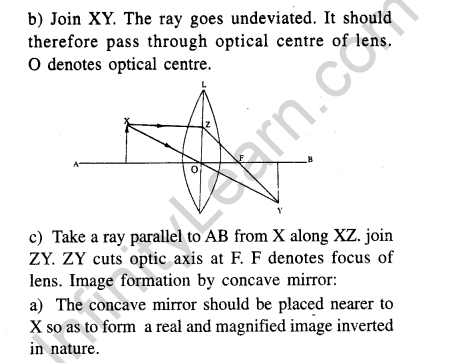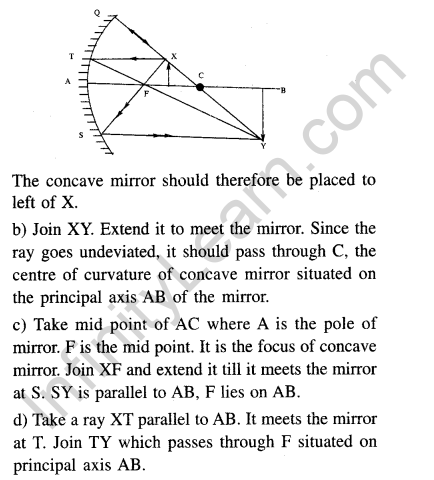For JEE Main other Engineering Entrance Exam Preparation, JEE Main Physics Optics Previous Year Questions with Solutions is given below.
Multiple Choice with ONE correct answer
1.When a ray of light enters a glass slab from air ! [1980-1 mark]
a) its wavelength decreases.
b) its wavelength increases.
c) its frequency increases.
d) neither its wavelength nor its frequency changes.
Ans.
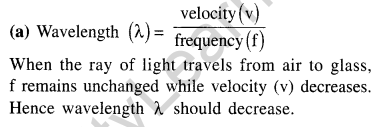
Join Our Courses: JEE Class 11 Students | JEE Class 12 Students | JEE Dropper
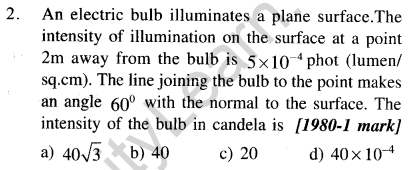
Ans.
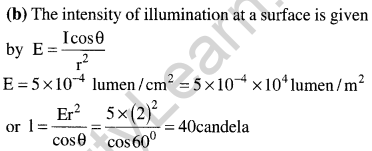
3.In Young’s double slit experiment, the separation between the slits is halved and the distance
between the slits and the screen is doubled. The finge width is [1981-2 marks]
a)unchanged b) halved
c) doubled d) quadrupled
Ans.
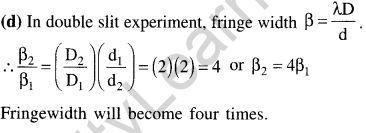
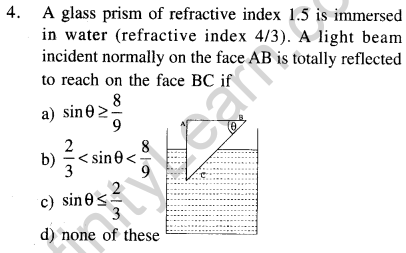
Ans.(a) Total internal reflection occurs when the ray of light travels from denser medium to rarer medium and the angle of incidence is greater than the critical angle.
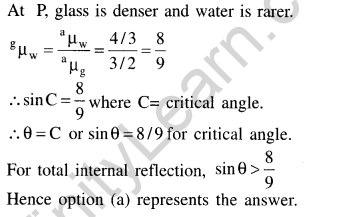
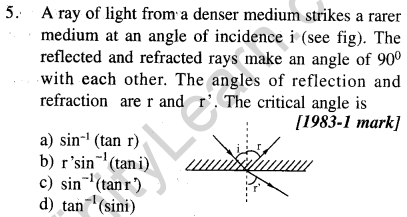
Ans.
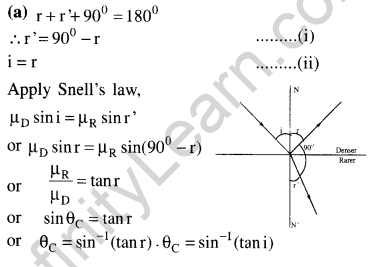
6.Two coherent monochromatic light beams of intensities I and 41 are superposed. The maximum and minimum possible intensities in the resulting beam are [1988-1 mark]
a)51 and I b) 51 and 31
c) 91 and I d) 91 and 31
Ans.

7.Spherical aberration, in a thin lens, can be reduced by [1994-1 mark]
a)using a monochromatic light ‘
b)using a doublet combination
c)using a circular annular mask over the lens
d)increasing the size of the lens.
Ans.(c) Spherical aberration is caused because the marginal rays and the paraxial rays incident on a lens are brought to focus at different points.To reduce spherical aberration, the marginal rays are blocked by using a circular annular mask over the lens.
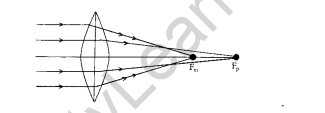
8.A beam of light of wavelength 600 nm, from a distant source, falls on a single slit 1 mm wide and a resulting diffraction pattern is observed on a screen 2 m away. The distance between the first dark fringes on either side of central bright fringe is [1994-1 mark]
a)1.2 cm b) 1.2 mm
c) 2.4 cm d) 2.4 mm
Ans.
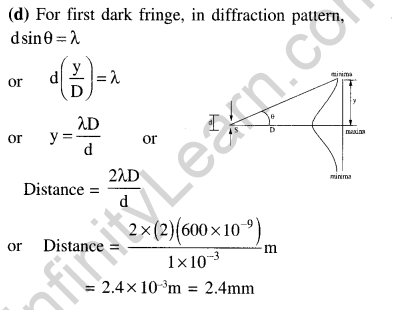
9.An isosceles prism of angle 120° has a refractive index 1.44. Two parallel monochromatic rays enter the prism, parallel to each other in air, as shown. The rays which emerge from the opposite faces [1995-2 marks]

Ans.
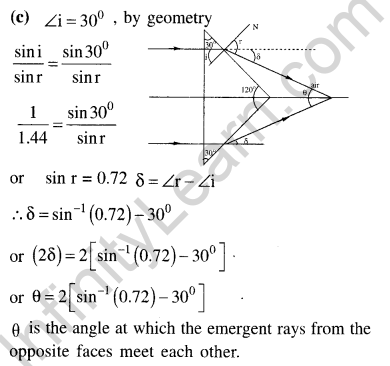
10.The focal lengths of the objective and the eye piece of a compound microscope are 2.0 cm and 3.0 cm, respectively. The distance between the objective and the eyepiece is 15.0 cm. The final image formed by the eyepiece is at infinity. The two lenses are thin. The distance, in cm, of the object and the image produced by the objective, measured from the objective lens, are respectively.[1995-2 marks]
a)2.4 and 12.0 b) 2.4 and 15.0
c) 2.0 and 12.0 d) 2.0 and 3.0
Ans.(a) The eyepiece forms the final image at infinity. Its object should therefore lie at its focus.‘F’ denotes focus of eyepiece. ‘I’ denotes image formed by the objective lens which serves as object for eye piece. It should be at 3 cm from eyepiece.
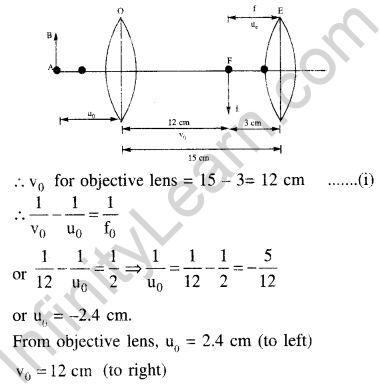
11.Consider Fraunhofer diffraction pattern obtained with a single slit illuminated at normal incidence. At the angular position of the first diffraction minimum, the phase difference (in radian) between the wavelets from the opposite edges of the slit is [1995]
![]()
Ans.
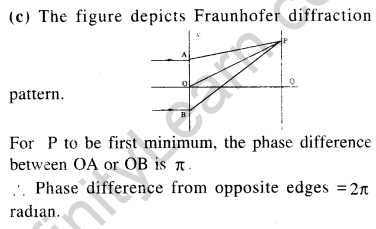
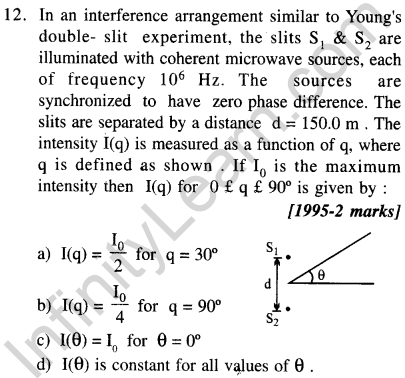
Ans.
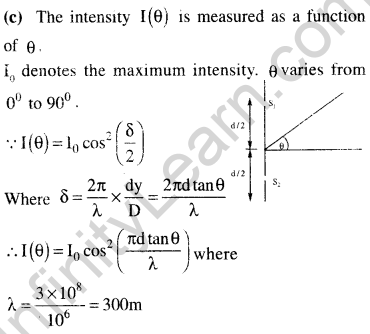
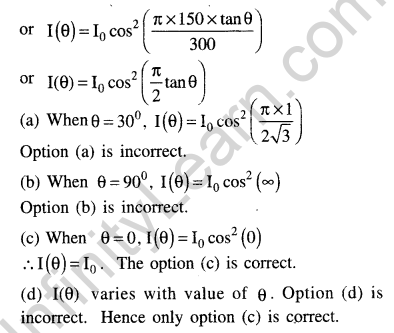
13.An eye specialist prescribes spectacles having a combination of convex lens of focal length 40 cm in contact with a concave lens of focal length 25 cm . The power of this lens combination, in dioptre is [1997-1 mark]
a)+1.5 b) -1.5 c) +6.67 d) -6.67
Ans.

14.A concave lens of glass, refractive index 1.5, has both surfaces of same radius of curvature R. On immersion in a medium of refractive index 1.75, it will behave as a [1999-2 marks]
a)convergent lens of focal length 3.5R
b)convergent lens of focal length 3.0 R.
c)divergent lens of focal length 3.5 R
d)divergent lens of focal length 3.0 R
Ans.

15.Yellow light is used in a single slit diffraction experiment with slit width of 0.6 mm. If yellow light is replaced by X-rays, then the observed pattern will reveal, [1999-2 marks]
a)that the central maximum in narrower
b)more number of fringes
c)less number of fringes
d)no diffraction pattern.
Ans.
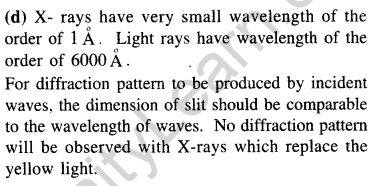
16.A thin slice is cut out of a glass cylinder along a plane parallel to its axis. The slice is placed on a flat glass plate as shown in figure. The observed interference fringes from this combination shall be [1999-2 marks]
a)straight
b)circular
c)equally spaced
d)having fringe spacing which increases as we go outwards.

Ans.(a) Locus of equal path difference consists in the lines running parallel to the axis of the cylinder. Hence fringes obtained are straight.
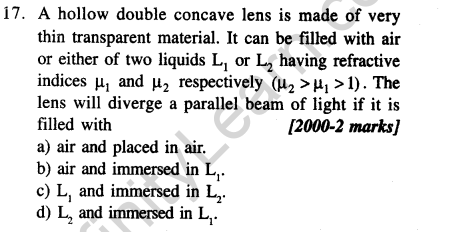
Ans.
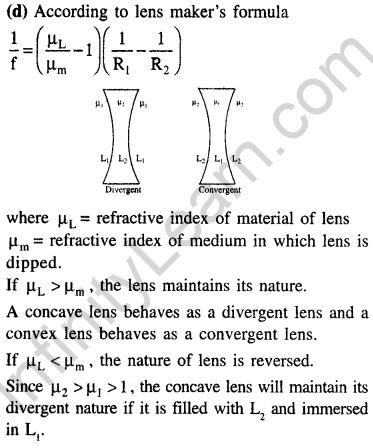
18.A point source of light B is placed at a distance L in front of the centre of a mirror of width d hung vertically on a wall. A man walks in front of the mirror along a line parallel to the mirror at a distance 2L from it as shown in figure. The greatest distance over which he can see the image of the light source in the mirror is [2002-2 marks]
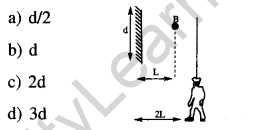
Ans.
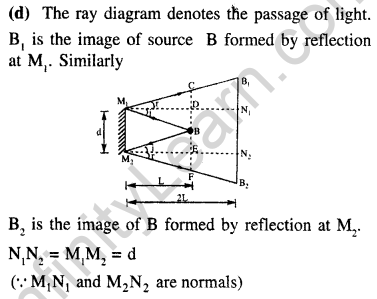
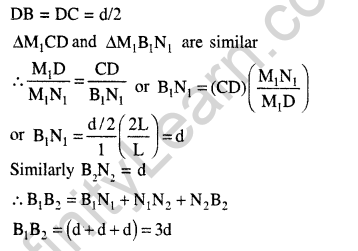
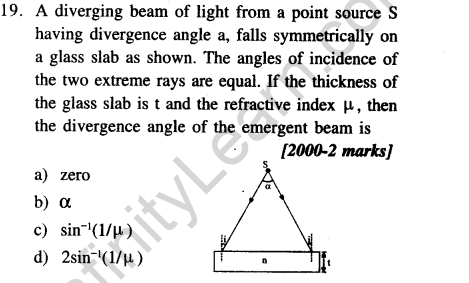
Ans.
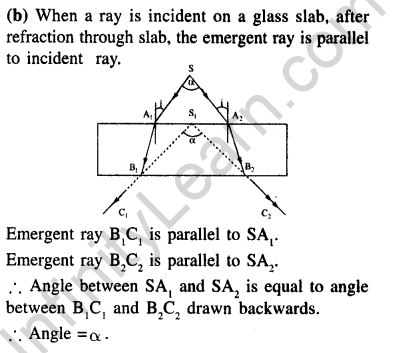

JEE Foundation Class for 10
JEE Foundation Class for 10 enhances critical thinking and problem-solving skills through engaging activities and advanced learning techniques, ensuring academic excellence.
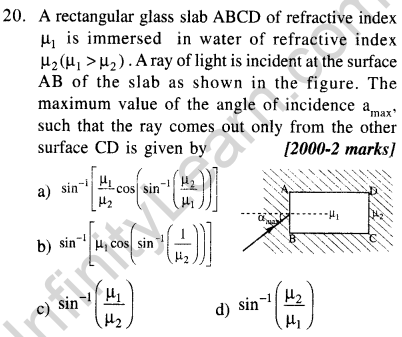
Ans.(a) Rays come out only from the surface CD when the light is incident at the surface AB of the slab. It means that rays after refraction from AB undergo total internal reflection at surface AD of the slab.
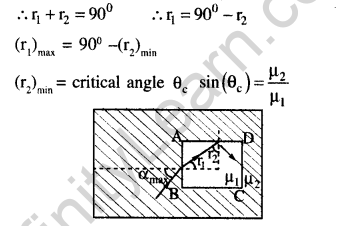
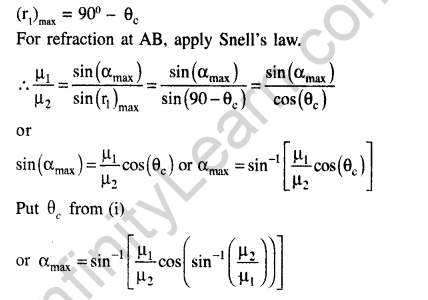
21.In a double slit experiment, instead of taking slits of equal widths, one slit is made twice as wide as the other. Then, in the interference pattern[2000-2 marks]
a)the intensities of both the maxima and the minima increase.
b)the intensity of the maxima increases and the minima has zero intensity.
c)the intensity of the maxima decreases and that of the minima increases.
d)the intensity of the maxima decreases and the minima has zero intensity.
Ans.
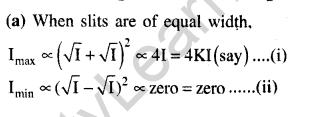
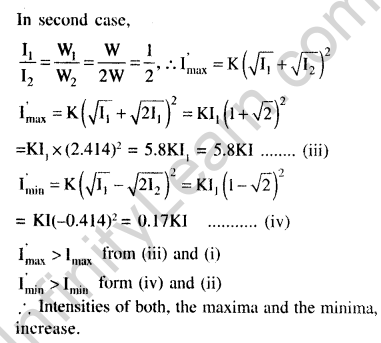
22.In a compound microscope, the intermediate image is [2000-2 marks]
a)virtual, erect and magnified
b)real, erect and magnified
c)real, inverted and magnified
d)virtual, erect and reduced.
Ans.(c) The intermediate image in a compound microscope is real, inverted and magnified.
23.Two beams of light having intensities I and 4I interfere to produce a fringe pattern on a screen. The phase difference between the beams is p/2 at point A and p at point B. Then the difference between the resultant intensities at A and B is [JEE (Scr.) 2001-2M]
a) 2I b) 4I c) 5I d) 7I
Ans.
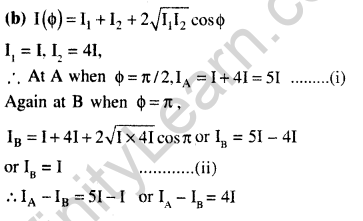
24.In young’s double slit experiment, 12 fringes are observed to be formed in a certain segment of the screen when light of wavelength 600 nm is used. If the wavelength of light is changed to 400 nm, number of fringes observed in the same segment of the screen is given by [2001-1 mark]
a) 12 b) 18 c) 24 d) 30
Ans.
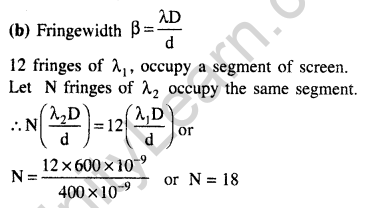
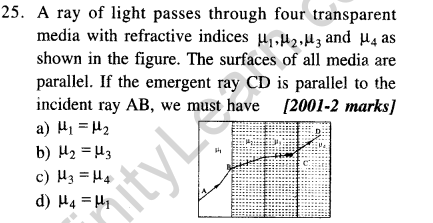
Ans.
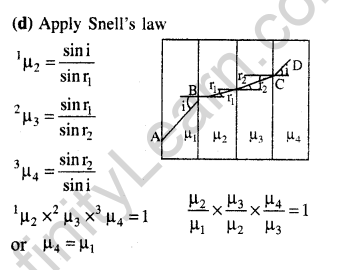
26.A given ray of light suffers minimum deviation in an equilateral prism P. Additional prism Q and R of identical shape and of the same material as P are now added as shown in the figure. The ray will now suffer [2001-2 marks]
a)greater deviation
b)no deviation
c)same deviation as before
d)total internal reflection

Ans.
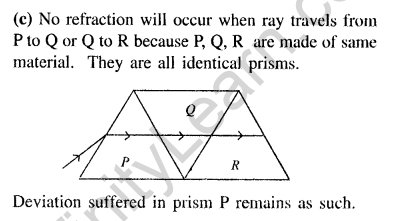
27.An observer can see through a pin-hole the top end of a thin rod of height h, placed as shown in the figure. The beaker height is 3h and its radius h. When the beaker is filled with a liquid up to a height 2h, he can see the lower end of the rod. Then the refractive index of the liquid is[2002-2 marks]

Ans.

28.Which one of the following spherical lenses does not exhibit dispersion? The radii of curvature of the surfaces of the lenses are as given in the diagrams. [2002-2 marks]
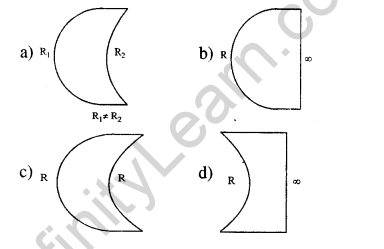
Ans.
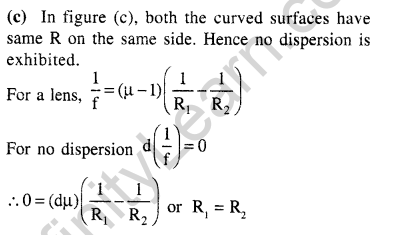
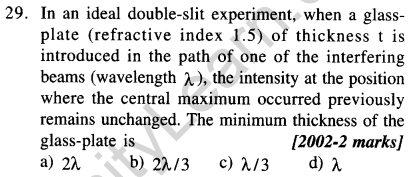
Ans.

30.Two plane mirrors A and B are aligned parallel to each other, as shown in the figure. A light ray is incident at an angle of 30° at a point just inside one end of A. The plane of incidence coincides with the plane of the figure. The maximum number of times the ray undergoes reflections (including the first one) before it emerges out is [2002-2 marks]

Ans.
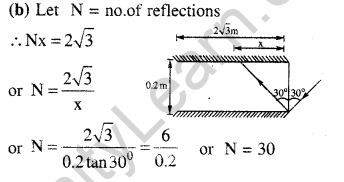
31.In the given diagram, CP represents a wavefront and AO and BP, the corresponding two rays. Find the condition in q for constructive interference at P between the ray BP and reflected ray OP.
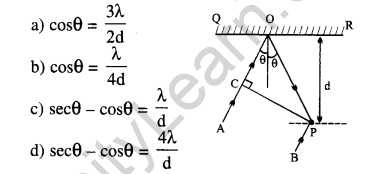
Ans.
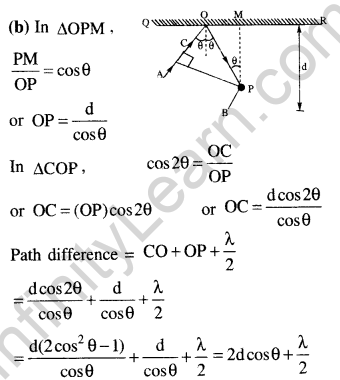

32.The size of the image of an object, which is at infinity, as formed by a convex lens of focal length 30 cm is 2 cm. If a concave lens of focal length 20 cm is placed between the covex lens and the image at a distance of 26 cm from the convex lens,calculate the new size of the image[2003-2 marks]
a) 1.25 cm b) 2.5 cm c) 1.05 cm d) 2 cm
Ans.
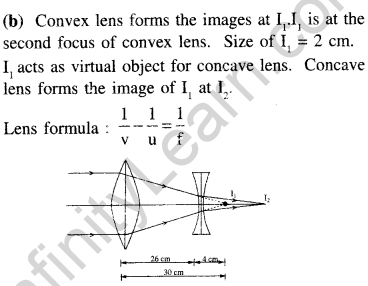

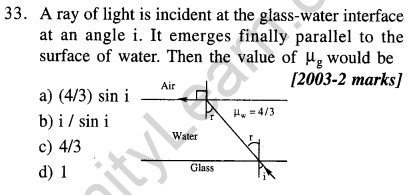
Ans.
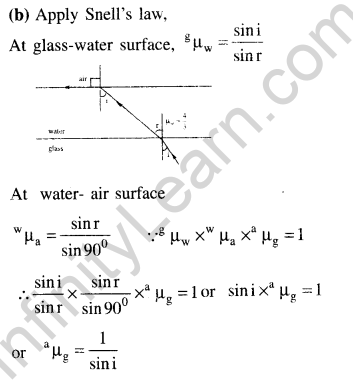
34.A beam of white light is incident on glass air interface from glass to air such that green light just suffers total internal reflection. The colours of the light which will come out to air are[2004-2 marks]
a)violet, indigo, blue
b)all colours except green
c)yellow, orange, red
d) white light
Ans.
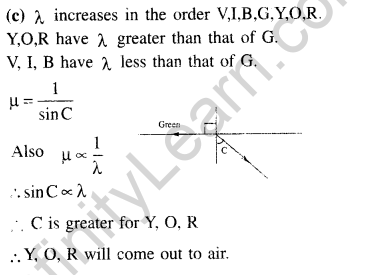
35.An equilateral prism is placed on a horizontal surface. A ray PQ is incident onto it. For minimum deviation. [2004-2 marks]
a)PQ is horizontal
b)QR is horizontal
c)RS is horizontal
d)any one will be horizontal

Ans.
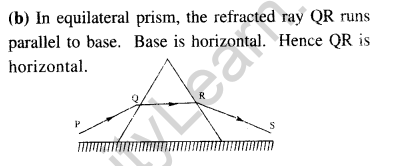
36.Monochromatic light of wavelength 400 nm and 560 nm are incident simultaneously and normally on double slit apparatus whose slit separation is 0.1 mm and screen distance is lm. Distance between areas of total darkness will be [2004-2 marks]
a) 4mm b) 5.6mm c) 14mm d) 28mm
Ans.(d) At the area of total darkness, in double slit apparatus, minima will occur for both the wavelengths which are incident simultaneously and normally.
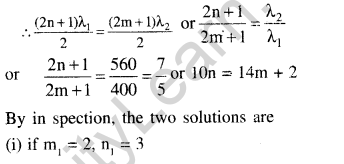
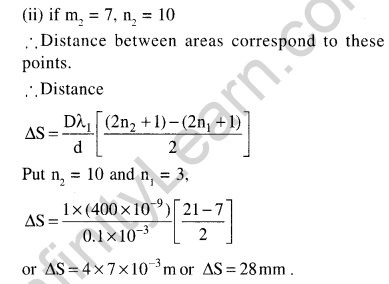
37.A source emits sound of frequency 600 Hz inside water. The frequency heard in air will be equal to (velocity of sound in water = 1500 m/s, velocity of sound in air = 300 m/s) [2004-2 m]
a) 3000 Hz b)120Hz c) 600Hz d) 6000 Hz
Ans.(c) Frequency of sound = 600 Hz inside water. Frequency of a wave depends on the source and it does not change during refraction when wave travels from one medium to another.
Frequency heard in air = 600 Hz.
38.A point object is placed at the centre of a glass sphere of radius 6 cm and refractive index 1.5. The distance of the virtual image from the surface is [2004-2 marks]
a) 6 cm b) 4 cm c) 12 cm d) 9 cm
Ans.
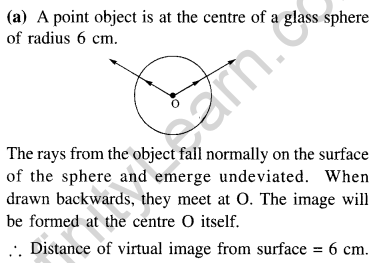
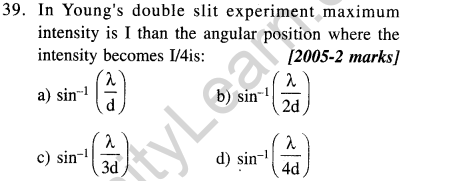
Ans.
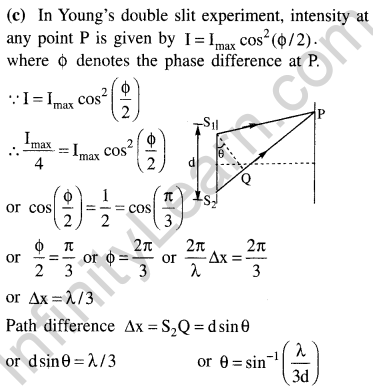
40.A convex lens is in contact with concave lens. The magnitude of the ratio of their focal lengths is 2/3. Their equivalent focal length is 30 cm. What are their individual focal lengths? [2005-2 marks]
a) -15,10 b) -10,15 c) 75, 50 d) -75,50
Ans.
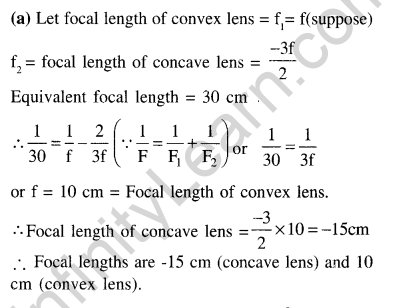
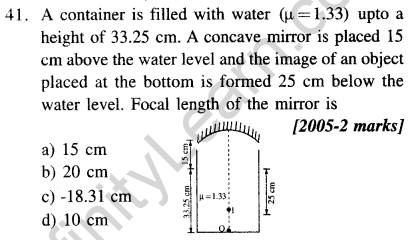
Ans.
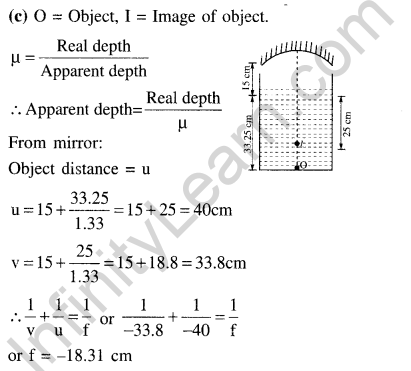
42.Focal length of the plano-convex lens is 15 cm. A small object is placed at A as shown in the figure. The plane surface is silvered. The image will form at [2006-3 marks]
a)60 cm to the left of lens
b)12 cm to the left of lens
c)60 cm to the right of lens
d)30 cm to the left of lens
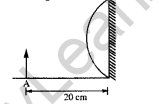
Ans.
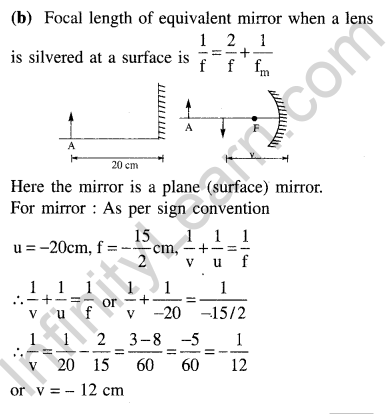

43.The graph shows relationship between object distance and image distance for an equiconvex lens. Then, focal length of the lens is. [2006-3 marks]
a)50 ±0.05 cm
b)50±0.10cm
c)00 ±0.05cm
d)5.00±0.10cm
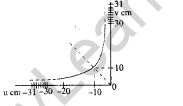
Ans.
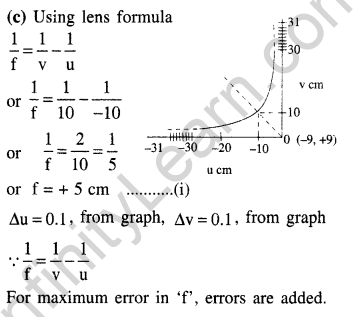
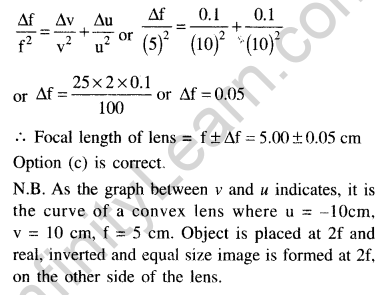
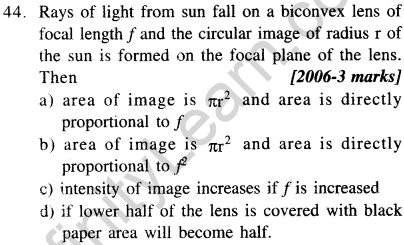
Ans.(b) Rays of light from sun are incident upon a biconvex lens. Sun is at infinity and incident rays form a parallel beam.The beam is brought to convergence in the focal plane of the lens. AB is image of the sun.
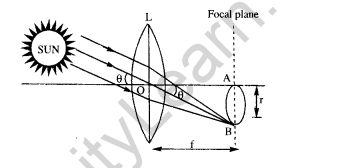
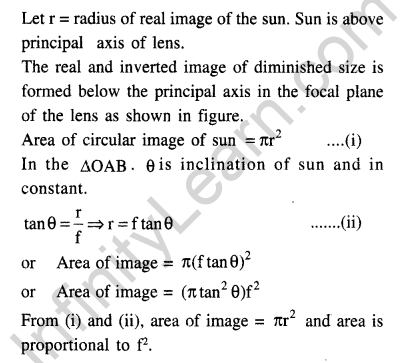
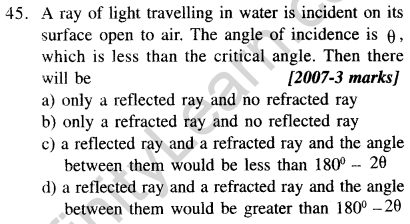
Ans.(c) The ray is incident on the interface of a rarer medium (air) from a denser medium (water), and the angle of incidence is less than the critical angle. The ray will be partly refracted and partly reflected
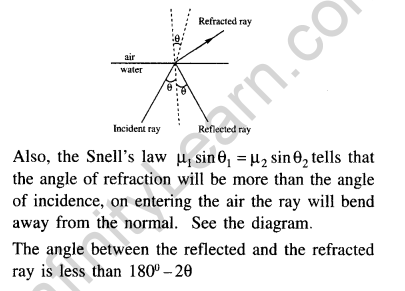
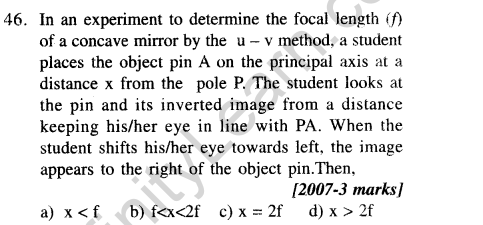
Ans.(b) On shifting the eye towards left, the image will appear to the right of the object pin if the image distance is more than the object distance and the image is real. This happens when the object lies between the focus and the centre of curvature, f < x<2f.
47.Two beams of red and violet colours are made to pass separately through a prism (angle of the prism is 60°). In the position of minimum deviation, the angle of refraction will be [2008]
a)30° for both the colours
b)greater for the violet colour
c)greater for the red colour
d)equal but not 30° for both the colours
Ans.

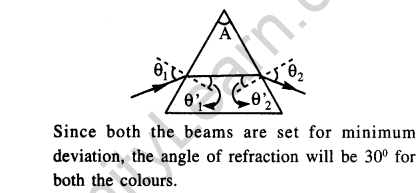

Ans.
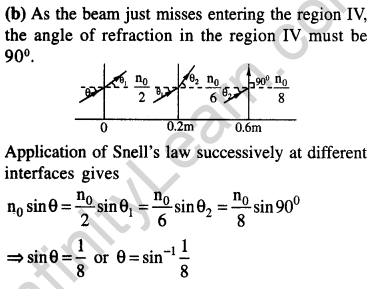
49.A ball is dropped from a height of 20 m above the surface of water in a lake. The refractive index of water is 4/3. A fish inside the lake, in the line of fall of the ball, is looking at the ball. At an instant, when the ball is 12.8 m above the water surface, the fish sees the speed of ball as [Take g = 10/s2],
a)9 m/s b) 12 m/s c) 16 m/s d) 21.33 m/s
Ans.
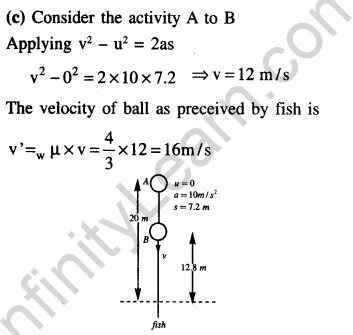
50.A biconvex lens of focal length 15 cm is in front of a plane mirror. The distance between thelens and the mirror is 10 cm. A small object is kept at a distance of 30 cm from the lens. The final image is
a)virtual and at a distance of 16 cm from the mirror
b)real and at a distance of 16 cm from the mirror
c)virtual and at a distance of 20 cm from the mirror
d)real and at a distance of 20 cm from the mirror
Ans.

Multiple Choice with ONE or More Than ONE correct answer
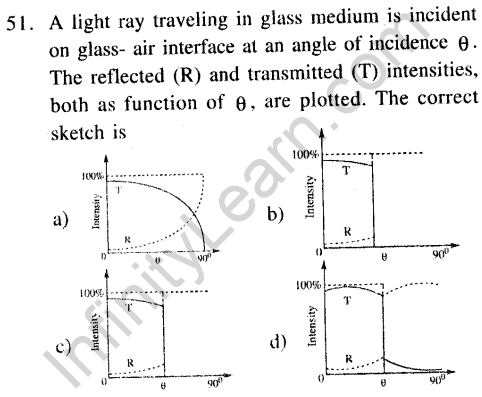
Ans.(c) 100% reflection or transmission not possible
52.In Young’s double slit experiment, the interference pattern is found to have an intensity ratio between the bright and dark fringes as 9. This implies that[1982-3 marks]
a) the intensities at the screen due to the two slits are 5 units and 4 units respectively
b) the intensities at the screen due to the two slits are 4 units and 1 unit respectively
c) the amplitude ratio is 3
d) the amplitude of ratio is 2.
Ans.
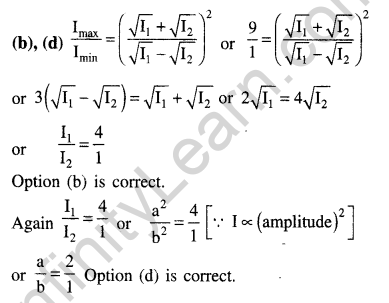
53.A convex lens of focal length 40 cm is in contact with a concave lens of focal length 25 cm. The power of the combination is [1982-3 marks]
a) -1.5 dioptre b) -6.5 dioptre
c)+6.5 dioptre d) +6.67 dioptre
Ans.
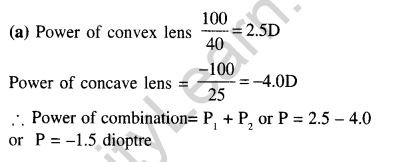
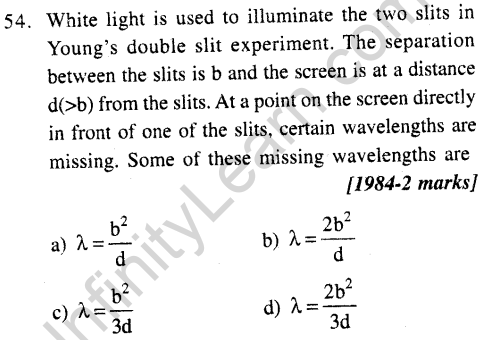
Ans.
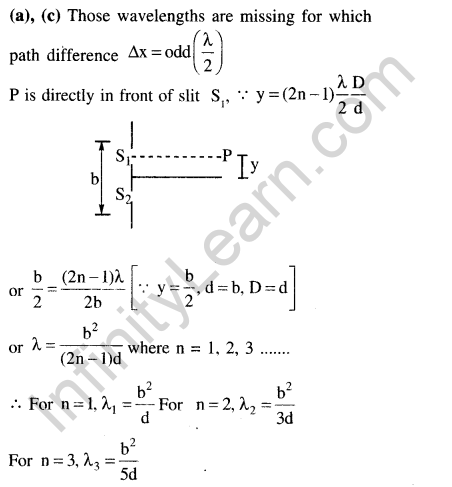
55.A converging lens is used to form an image on a screen. When the upper half of the lens is covered by an opaque screen [1986-2 marks]
a)half the image will disappear
b)complete image will be formed
c)intensity of the image will increase
d)intensity of the image will decrease
Ans.(b), (d) Image formed will be complete when upper half of lens is blocked.
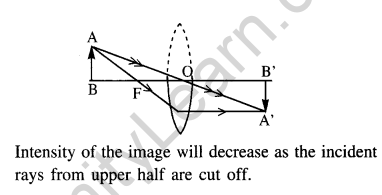
56.A short linear object of length b lies along the axis of a concave mirror of focal length f at a distance u from the pole of the mirror. The size of the image is approximately equal to [1988-2 marks]

Ans.
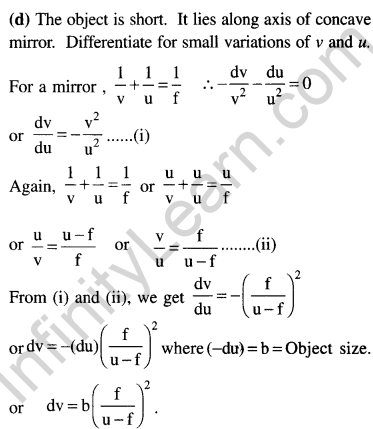
57.A beam of light consisting of red, green and blue colours is incident on a right angled prism, as shown in figure. The refractive indices of the material of the prism for the above red, green and blue wavelengths are 1.39, 1.44 and 1.47 respectively. The prism will [1989-2 marks]
a)separate part of the red colour from the green and blue colours
b)separate part of the blue colour from the red and green colours
c)separate all the three colours from one another
d)not separate even partially any colour from the other two colours.
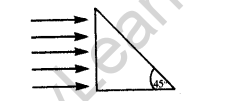
Ans.
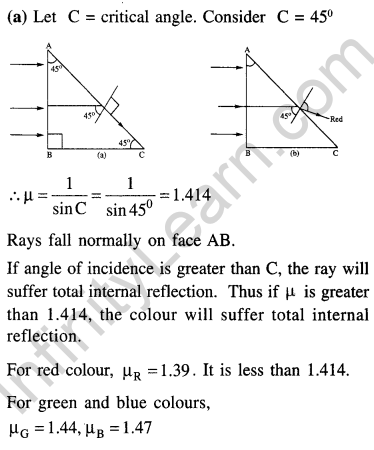

58.An astronomical telescope has an angular magnification of magnitude 5 for distant objects. The separation between the objective and the eyepiece is 36 cm and the final image is formed at infinity. The focal length f0 of the objective and the focal length fe of the eyepiece are
a)f0 = 45 cm and fe = -9 cm [1989-2 marks]
b)fo = 50 cm and fe = 10 cm
c)fo = 7.2 cm and fe = 5 cm
d)f0 = 30 cm and fe = 6 cm
Ans.
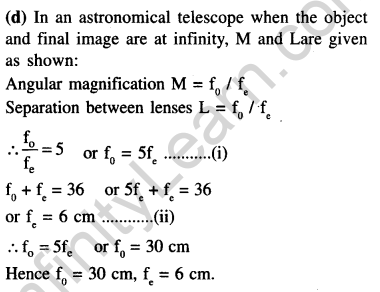
59.A thin prism P1, with angle 4° and made from glass of refractive index 1.54 is combined with another thin prism P2 made from glass of refractive index 1.72 to produce dispersion without deviation. The angle of the prism P2 is [1990-2 marks]
a) 5.33° b) 4° c) 3° d) 2.6°
Ans.
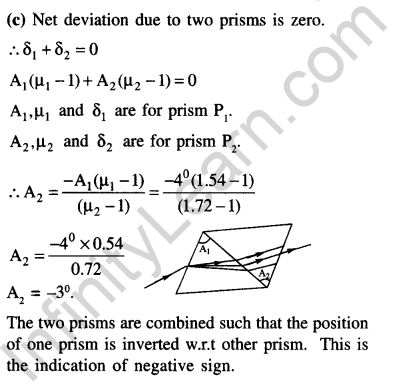
60.A planet is observed by an astronomical refracting telescope having an objective of focal length 16m and an eyepiece of focal length 2cm. [1992-2 marks]
a)The distance between the objective and the eyepiece is 16.02m
b)The angular magnification of the planet is -800
c)The image of the planet is inverted
d)The objective is larger than the eyepiece.
Ans.
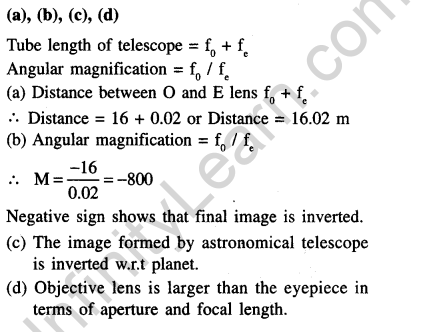
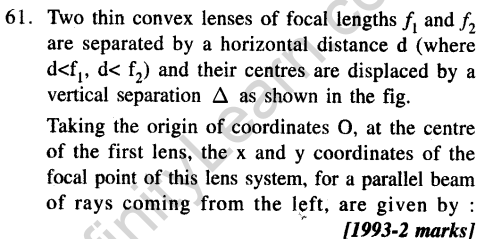
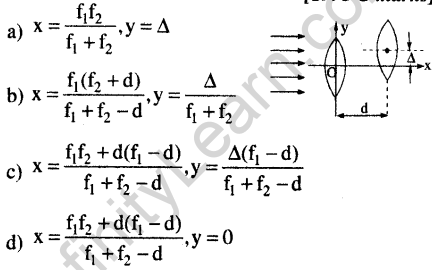
Ans.(c) A parallel beam of rays coming from the left is incident on the first lens of focal length fr The lens forms the image (It) at its focus. The image (Ij) serves as virtual object for second lens. The second lens forms the final image I at distance v2 from the second lens. I is the focal point of the lens system.
(i) Let x denote the distance of I from O.
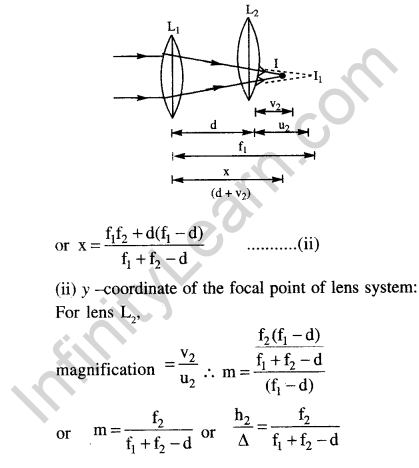
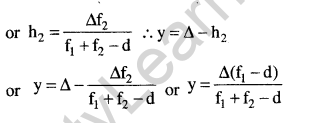
62.A diminished image of an object is to be obtained on a screen 1.0 m from it. This can be achieved by appropriately placing [1995-2 marks]
a)a concave mirror of suitable focal length
b)a convex mirror of suitable focal length
c)a convex lens of focal length less than 0.25m
d)a concave lens of suitable focal length
Ans.(a), (c) An image obtained on screen is a real image. Convex mirror and concave lens do not form real image of an object.Options (b) and (d) do not hold good.Options (a) and (c) hold good. They are correct. For concave mirror, the object should be beyond C to form a real diminished image between F and C of mirror.

63.Which of the following form(s) a virtual & erect image for all positions of the object?[1996-2 marks]
a) Convex lens b) Concave lens
c) Convex mirror d) Concave mirror.
Ans.(b),(c) Concave lens and convex mirror are diverging in nature. For all positions of objects, they form virtual and erect image.
64.A real image of a distant object is formed by a plano-convex lens on its principal axis. Spherical aberration [1998-2 marks]
a)is absent
b)is smaller if the curved surface of the lens faces the object
c)is smaller if the plane surface of the lens faces the object
d)is the same whichever side of the lens faces the object
Ans.(b) Spherical aberration is smaller if the curved surface of the lens faces the object. The total deviation is shared between the curved and the plane surfaces.
65.A ray of light travelling in a transparent medium falls on a surface separating the medium from air at an angle of incidence 45°. The ray undergoes total internal reflection. If M is the refractive index of the medium with respect to air, select the possible value(s) of p from the following [1998-2 marks]
a) 1.3 b) 1.4 c) 1.5 d) 1.6
Ans.
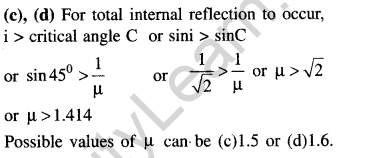
66.A parallel monochromatic beam of light is incident normally on narrow slit. A diffraction pattern is formed on a screen placed perpendicular to the direction of the incident beam. At the first minimum of the diffraction pattern, the phase difference between the rays coming from the two edges of the slit is [1998-2 marks]
![]()
Ans.

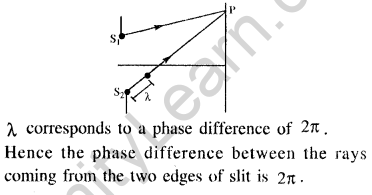
67.A concave mirror is placed on a horizontal table, with its axis directed vertically upwards. Let O be the pole of the mirror & C its centre of curvature. A point object is placed at C. It has a real image, also located at C. If the mirror is now filled with water, the image will be: [1998-2 marks]

Ans.
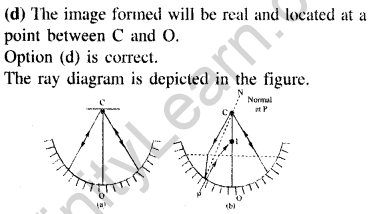
68.A spherical surface of radius of curvature R separates air (refractive index 1.0) from glass (refractive index 1.5). The centre of curvature is in the glass. A point object P placed in air is found to have a real image Q in the glass. The line PQ cuts the siuface at a point O and PO = OQ . The distance PO is equal to [1998-2 marks]
a) 5R b) 3R c) 2R d) 1.5R
Ans.
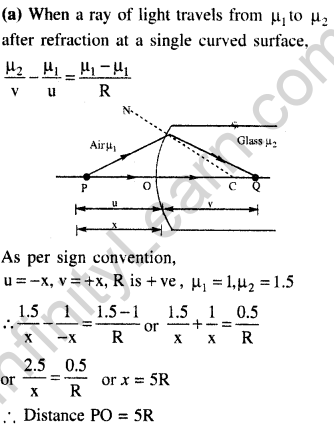
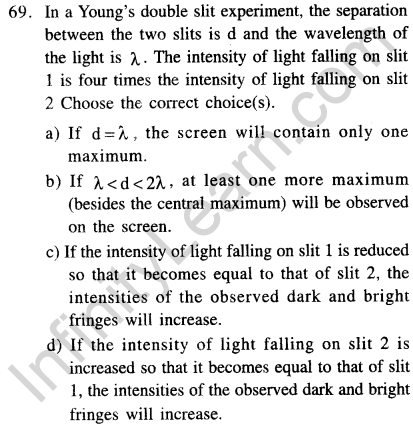
Ans.

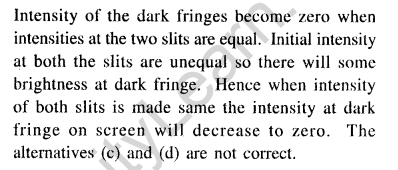
70.A student performed the experiment of determination of focal length of a concave mirror by u – v method using an optical bench of lengh 1.5 meter. The focal length of the mirror used is 24 cm. The maximum error in the location of the image can be 0.2 cm. The 5 sets of (u,v) values recorded by the student (in cm) are :(42,56), (48,48), (60,40), (66,33), (78,39).The data set(s) that cannot come from experiment and is (are) incorrectly recorded, is (are)
a)(42,56) b) (48,48) c) 66,33) d) 78,39)
Ans.
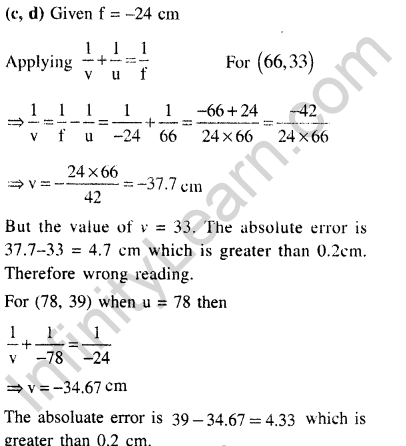
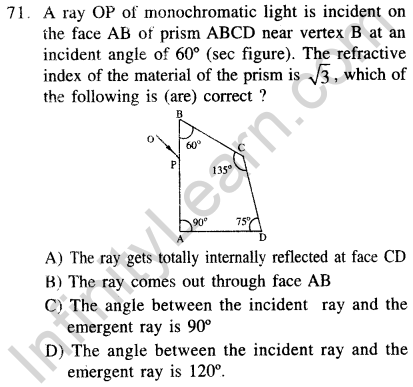
Ans.
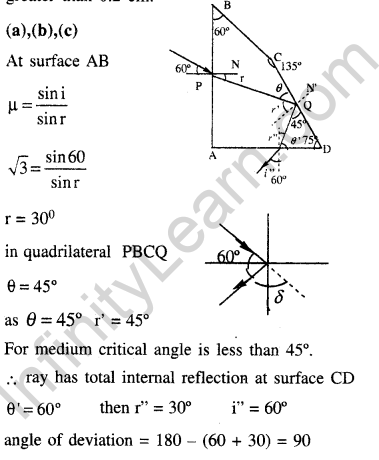
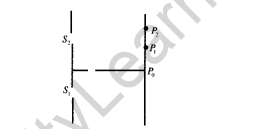
Assertion & Reason Type
Instructions The following question contains
statement-I (assertion) and statement -2 (reason). Of these statements, mark correct choice if
a)Statements-1 and 2 are true and statement-2 is a correct explanation for statement-1
b)Statements-1 and 2 are true and statement-2 is not a correct explanation for statement-1
c)Statement-1 is true, statement-2 is flase
d)Statement-1 is false, statement-2 is true
72.Statement-1 : The formula connecting u. v and f for a spherical mirror is valid only for mirrors whose sizes are very small compared to their radii of curvature.
Statement-2 : Laws of reflection are strictly valid for plane surfaces, but not for large spherical surfaces. [2007-3 marks]
Ans.
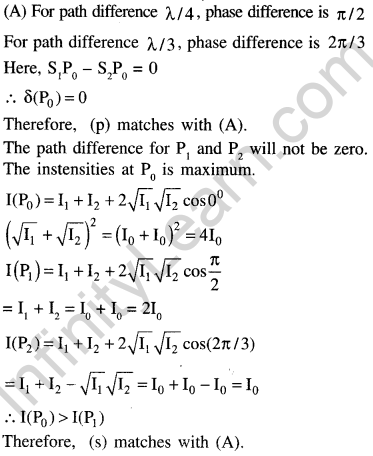
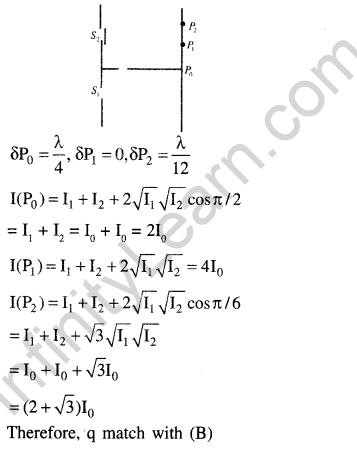
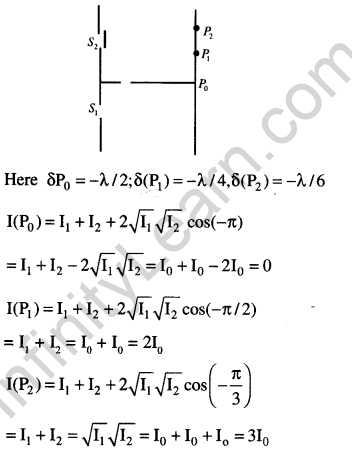

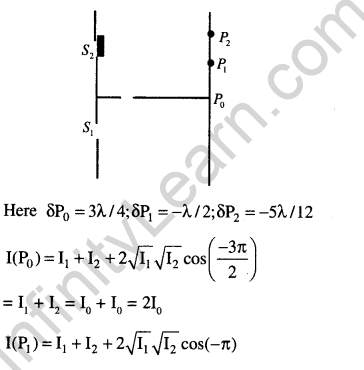
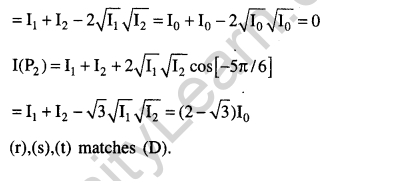
Comprehension based question type
Read the passage given below and answer the questions that follow
Paragraph-1: The figure shows a surface XY separating two transparent media, medium-1 and medium-2. The lines ab and cd represent wavefronts of a light wave travelling in medium- 1 and incident on XY. The lines ef and gh represent wavefronts of the light wave in medium-2 after refraction.
73.Light travels as a [2007-4 marks]
a)parallel beam in each medium
b)convergent beam in each medium
c)divergent beam in each medium
d)divergent beam in one medium and convergent beam in the other medium.

Ans.
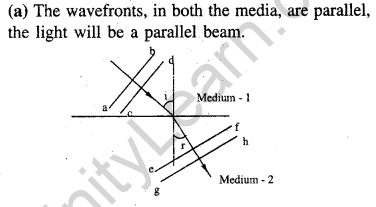

Ans.

75.Speed of light is [2007-4 marks]
a)the same in medium-1 and medium-2
b)larger in medium-1 than in medium-2
c)larger in medium-2 than in medium-1
d)different at b and d
Ans.(b) The ray diagram suggests that on entering medium- 2, the ray bends towards normal, medium-2 is denser than medium-1.
Matching Type
76.A simple telescope used to view distant objects has eyepiece and objective lenses of focal lengths fe and f0 respectively. Then [2006-6 m]
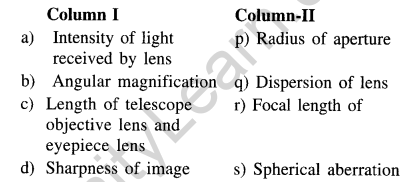
Ans.
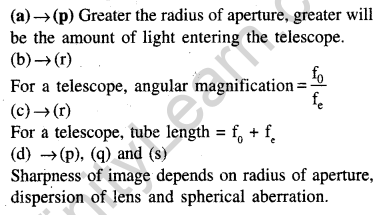
77.An optical component and an object S placed along its optic axis are given in Column I. The distance between the object and the component can be varied. The properties of images are given in Column II. Match all the properties of images from Column II with the appropriate components given in Column I.[2008]
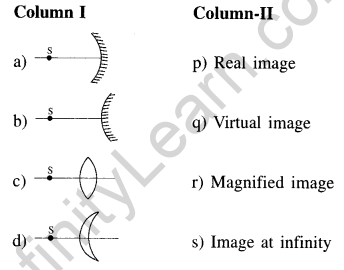
Ans.
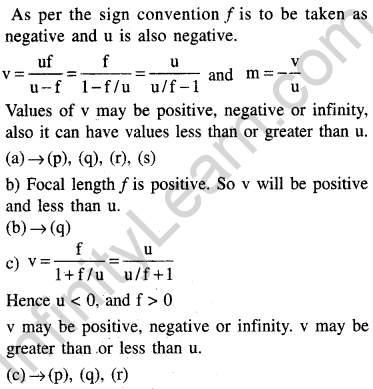
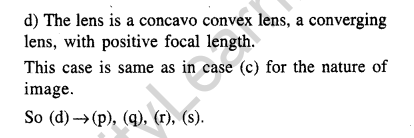
Subjective / Numerical integer type
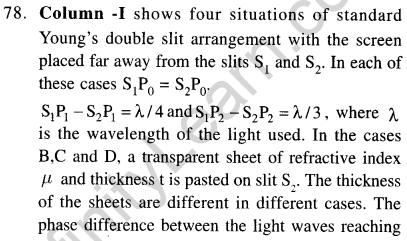
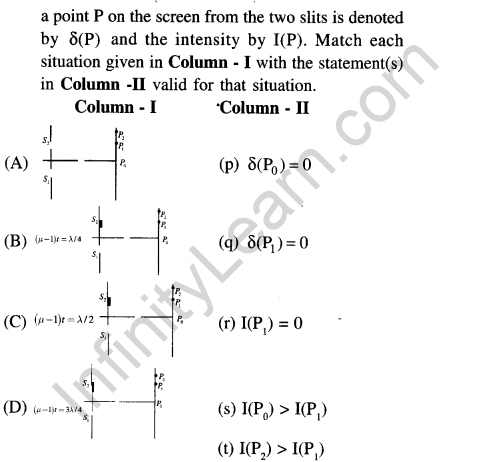
Ans.
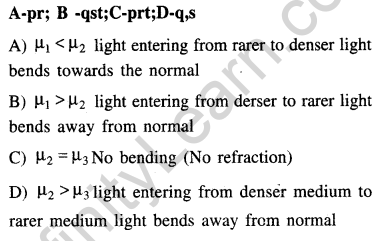
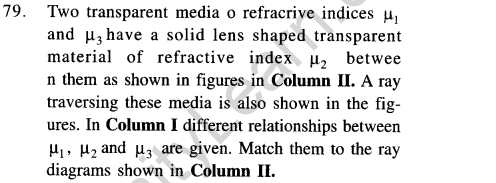
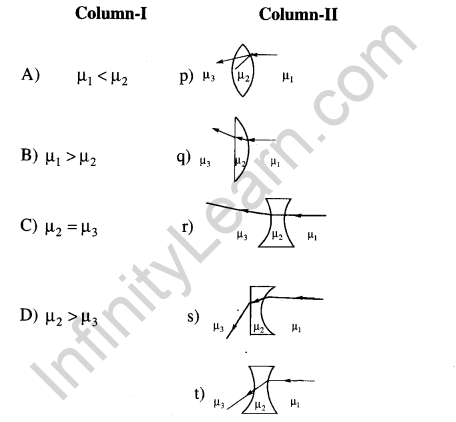
Ans.A->p,s; B ->q;C->t;D—»r,s,t
80.A ray of light is incident at angle of 60° on one face of a prism which has an angle of 30°. The ray emerging out of the prism makes an angle of 30° with the incident ray. Show that the emergent ray is perpendicular to the face through which it emerges and calculate the refractive index of the material of the lens. [1978]
Ans.(c) The formula is derived under paraxial approximation, only those rays are considered which make very small angle with the principal axis. This requires a small aperture.
Statement-1 is true. Statement-2 is false, the laws of reflection are valid whenever the light is reflected. Nature of surface does not matter
81.A pin is placed 10 cm in front of a convex lens of focal length 20cm and made of a material of refractive index 1.5. The surface of the lens farther away from the pin is silvered and has a radius of curvature of 22 cm. Determine the position of the final image. Is the image real or virtual? [1978]
Ans.
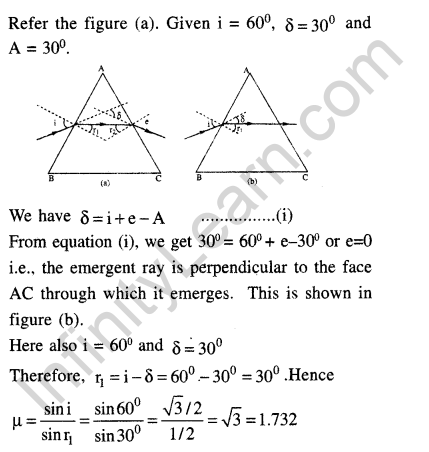
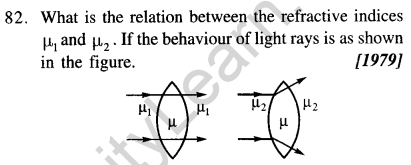
Ans.
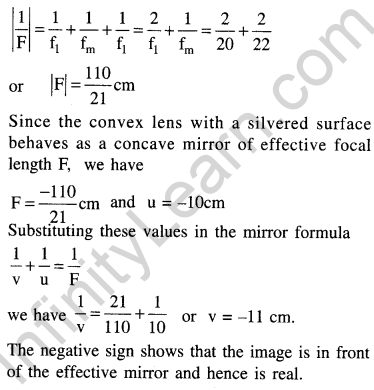
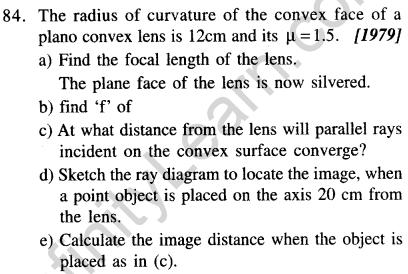
Ans.
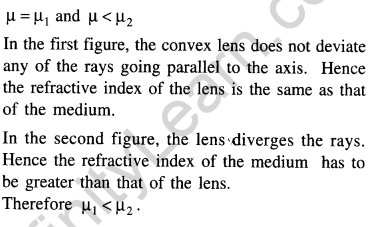
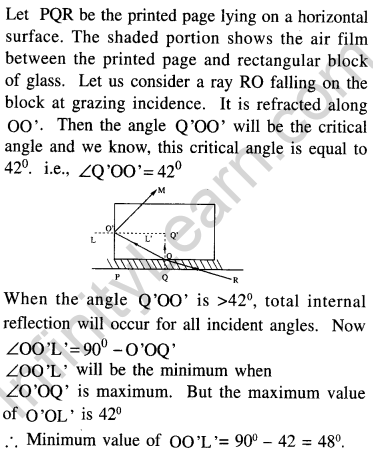
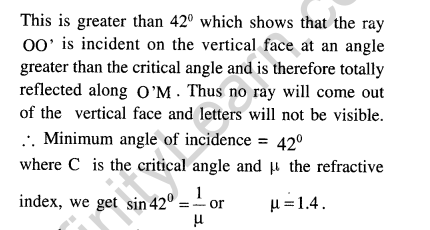
85.An object is placed 21 cm in front of a concave mirror of radius curvature 10 cm. A glass slab of thickness 3 cm and refractive index 1.5 is placed close to the mirror in the space between the object and the mirror. Find the position of the final image formed. The distance of the nearer surface of the slab from mirror to be 1 cm. [1980]
Ans.
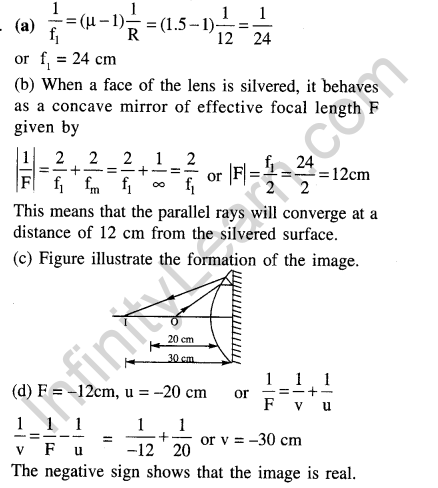
86.A telescope has an objective of focal length 50 cm and an eyepiece of focal length 5 cm. The least distance of distinct vision is 25 cm. The telescope is focussed for distinct vision on a scale 200 cm away from the objective. Calculate (a) the separation between the objective and the eyepiece and (b) the magnification produced [1980]
Ans.
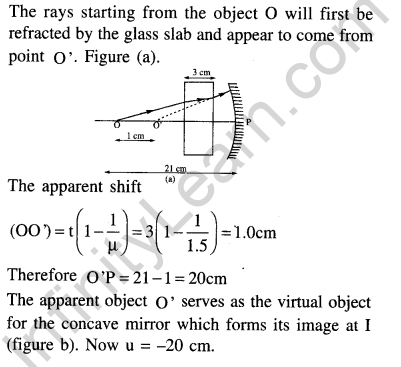
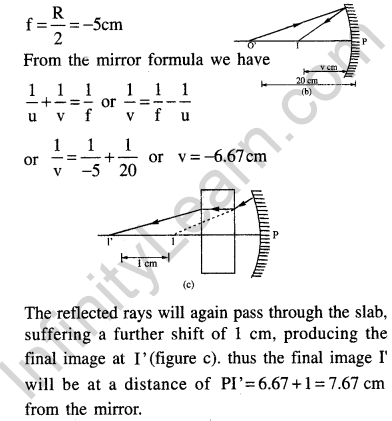
87.The convex surface of a thin concavo-convex lens of glass of refractive index 1.5 has a radius of curvature 20 cm. The concave surface has a radius of curvature 60 cm. The convex side is slivered and placed on a horizontal surface. [1981-6 marks]
i)where should a pin be placed on the optic axis such that its image is formed at the same place?
ii)If the concave part is filled with water of refractive index 4/3, find the distance through whcih the pin should be moved so that the image of the pin again coincides with the pin.

Ans.
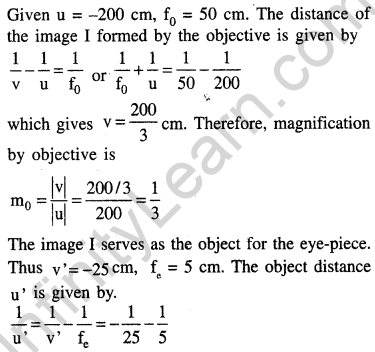
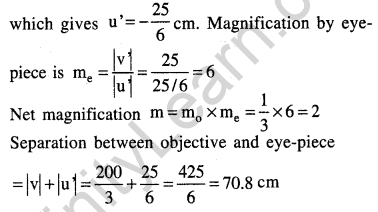
88.Screen S is illuminated by two point sources A and B. Another source C sends a parallel beam of light towards point P on the screen (see figure). Line AP is normal to the screen and the lines AP, BP and CP are in one plane. The distance AP, BP and CP are 3m, 1.5 m & 1.5m respectively. The radiant powers of sources A and B are 90 watt and 180 watt respectively. The beam from C is of intensity 20 watt/m2. Calculate the intensity at P on the screen. [1982-5 marks]

Ans.Whenever any surface of a convex or plano-convex or concave convex lens is silvered, it behaves like


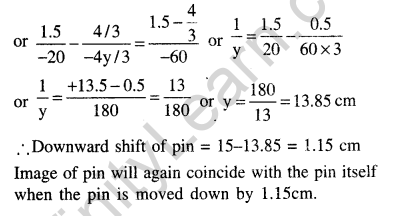
89.In Young’s double slit experiment using monochromatic light, the fringe pattern shifts by a certain distance on the screen, when a mica sheet of refractive index 1.6 and thickness 1.964 micron is introduced in the path of one of the interfering waves. The mica sheet is then removed and the distance between the slits and the screen is doubled. It is found that the distance between successive maxima (or minima) now is the same as the observed fringe shift upon the introduction of the mica sheet. Calculate the wavelength of the monochromatic light used in the experiment [1983-6 marks]
Ans.
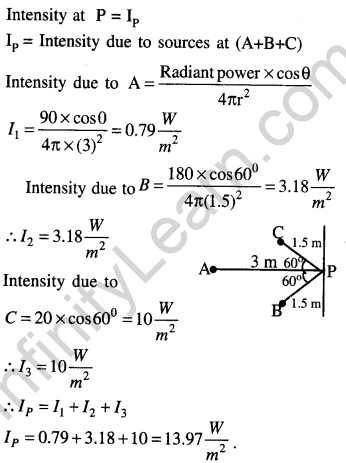
90.A piano convex lens has a thickness of 4 cm. When placed on a horizontal table, with the curved surface in contact with it, the apparent depth of the bottom most point of the lens is found to be 3 cm. If the lens is inverted such that the plane face is in contact with the table, the apparent depth of the centre of the palne face is found to be (25/8) cm. Find the focal length of the lens.
Ans.
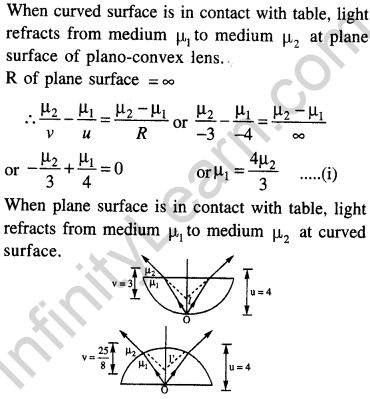
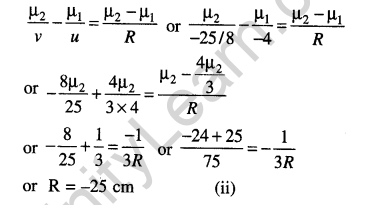
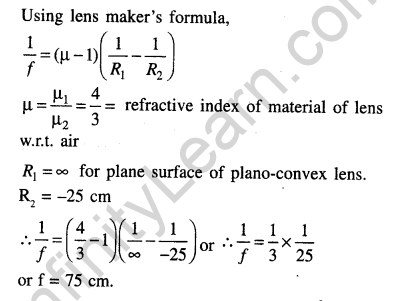
91.A beam of light consisting of two wavelengths, 6500 A and 5200 A, is used to obtain interference fringes in Young’s double slit experiment :
i)Find the distance of the third bright fringe on the screen from the central maximum for wavelength 6500 A
ii)What is the least distance from the central maximum where the bright fringes due to both the wavelengths coincide?
The distance between the slits is 2 mm and the distance between the plane of the slits and the screen is 120 cm. [1985-6 marks]
Ans.
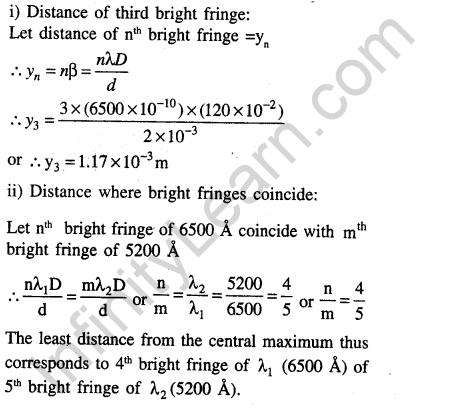
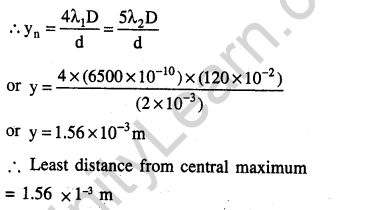
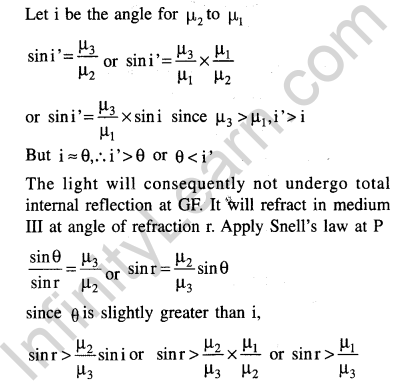
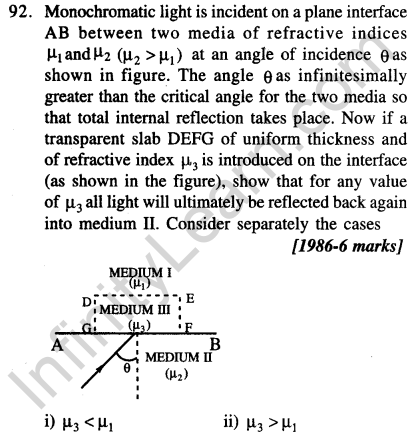
Ans.
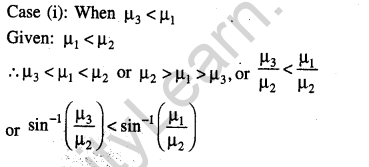
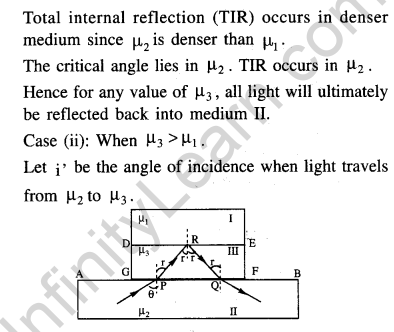
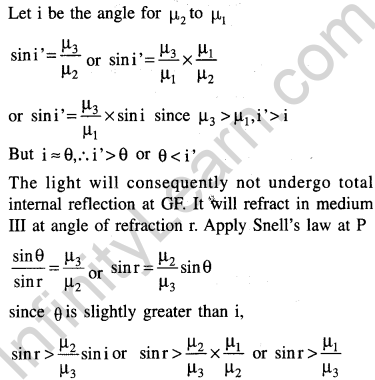
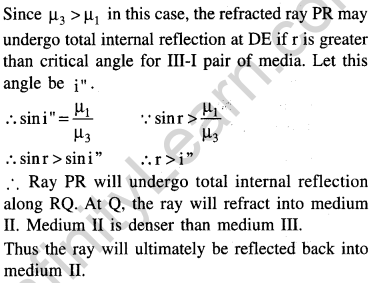
93.A right prism is to be made by selecting a proper material and the angles A and B (B < A), as shown in figure. It is desired that a ray of light incident on the face AB emerges parallel to the incident direction after two internal reflections.
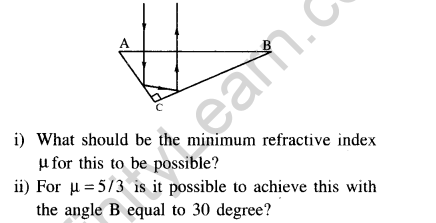
Ans.

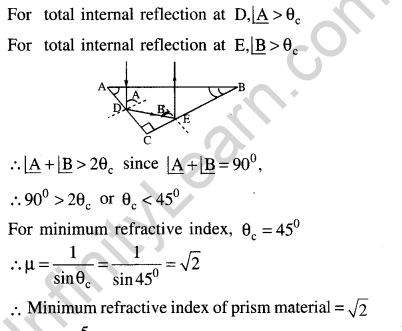

94.A parallel beam of light travelling in water (refractive index =4/3) is refracted by a spherical air bubble of radius 2 mm situated in water. Assuming the light rays to be paraxial. ‘[1988-6 marks]
i)Find the position of the image due to refraction at the first surface and the position of the final image.
ii)Draw a ray diagram showing the positions of both the images.
Ans.
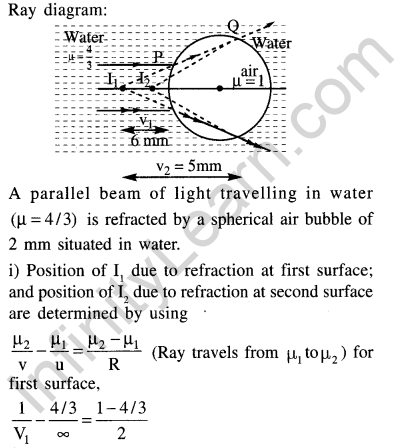
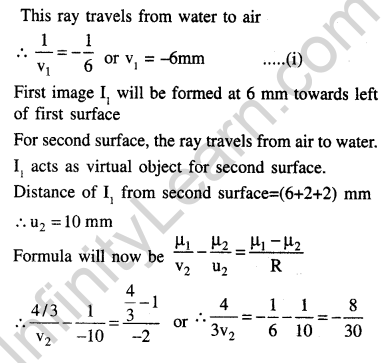
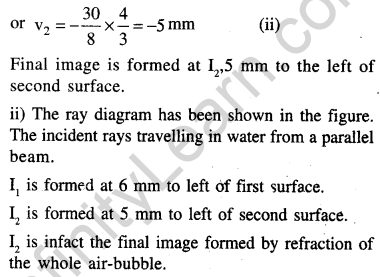
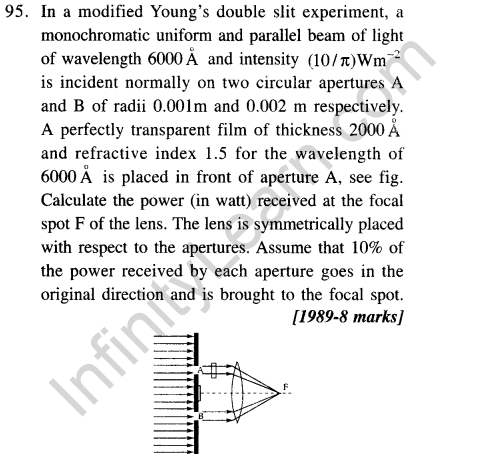
Ans.
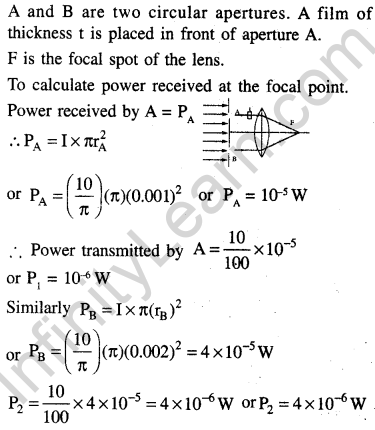
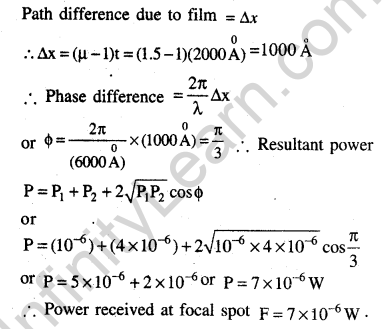
96.A narrow monochromatic beam of light of intensity I is incident on a glass plate as shown in figure. Another identical glass plate is kept close to the first one and parallel to it. Each glass plate reflects 25 percent of the light incident on it and transmits the remaining. Find the ratio of the minimum and the maximum intensities in the interference pattern formed by the two beams obtained after one reflection at each plate.
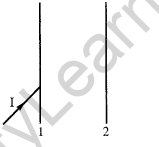
Ans.
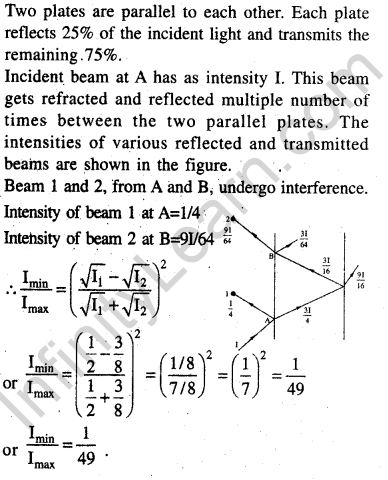
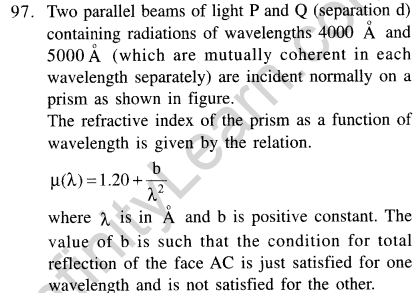
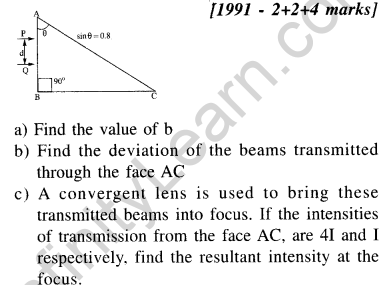
Ans.
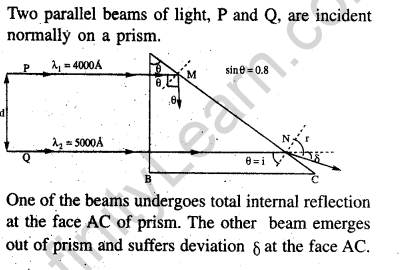
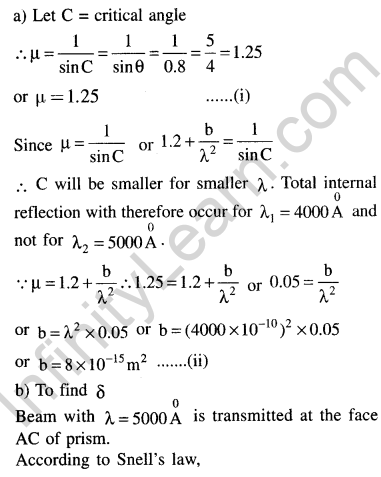
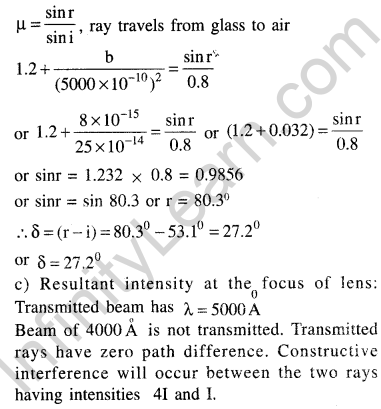
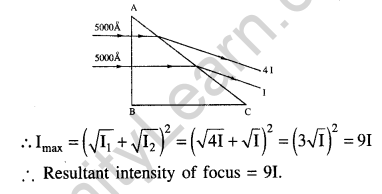

Ans.
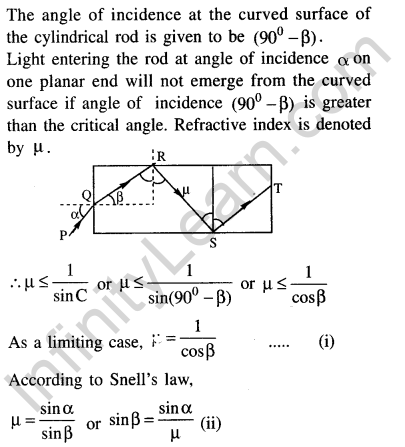
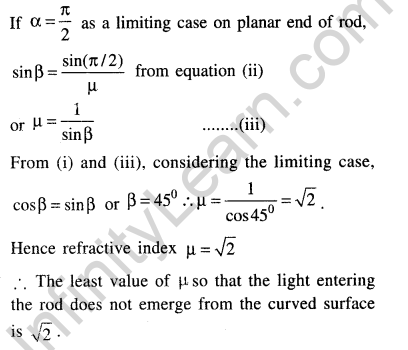

Ans.
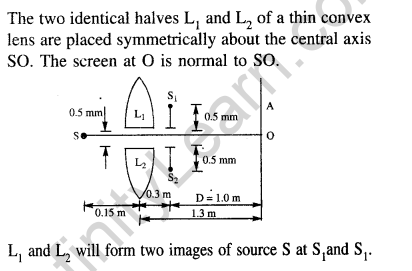

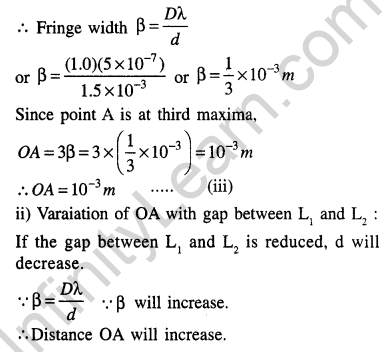
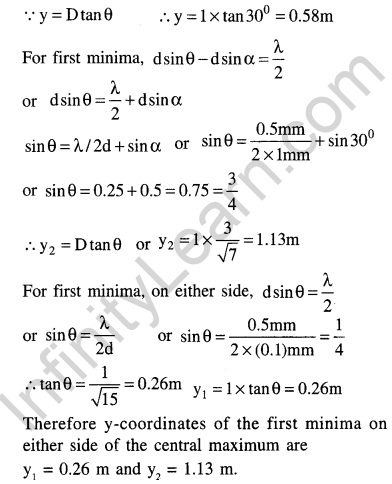
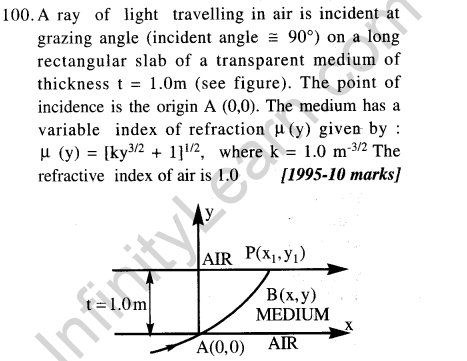
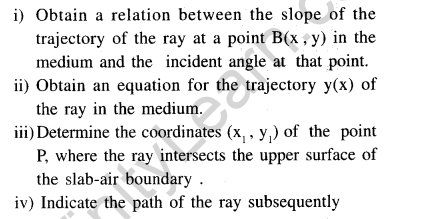
Ans.
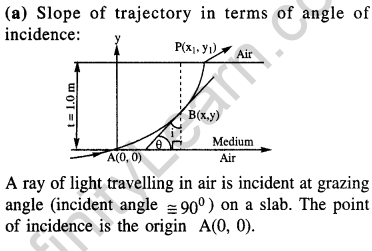
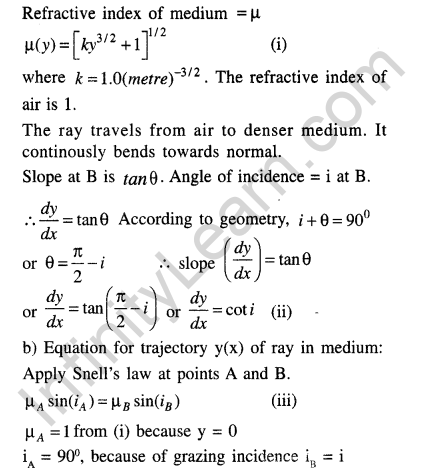
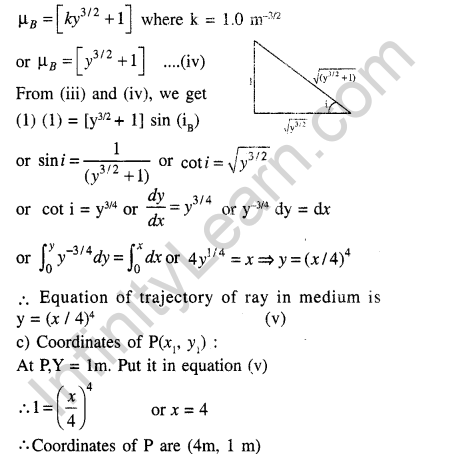


101.Angular-width of central maximum in the Fraunhofer diffraction pattern of a slit is measured. The slit is illuminated by light of wavelength 6000 A . When the slit is illuminated by light of another wavelength, the angular-width decreases by 30%. Calculate the wavelength of this light. The same decrease in the angular-width of central maximum is obtained when the original apparatus is immersed in a liquid. Find refractive index of the liquid. [1996-2 marks]
Ans.
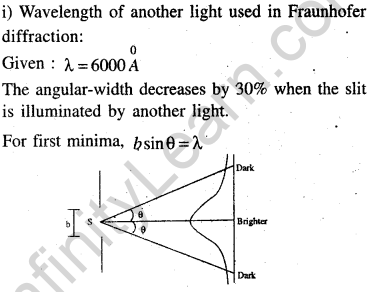
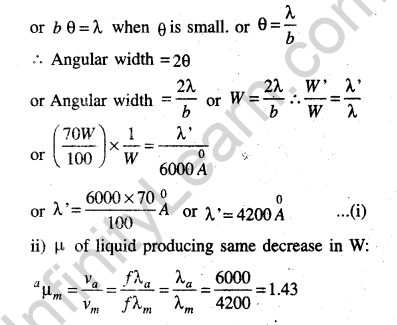
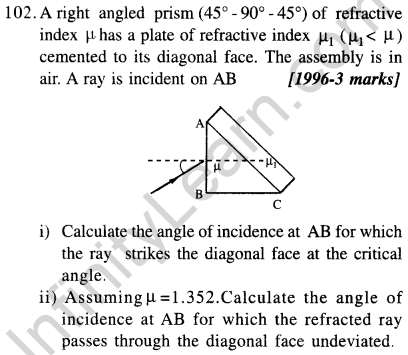
Ans.
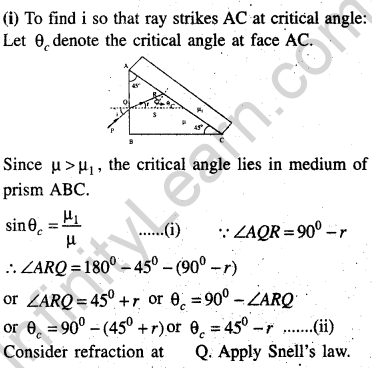

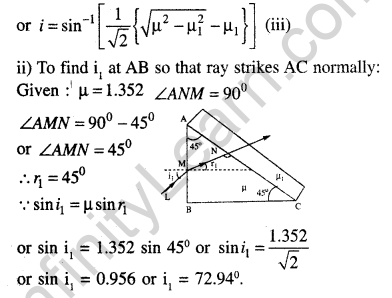
103.A double – slit apparatus is immersed in a liquid of refractive index 1.33 . It has slit separation of 1 mm & distance between the plane of slits & screen is 1.33 m. The slits are illuminated by a parallel beam of light whose wavelength in air is 6300 A [1996-3 marks]
a)Calculate the fringe width .
b)One of the slits of the apparatus is covered by a thin glass sheet of refractive index 1.53 . Find the smallest thickness of the sheet to bring the adjacent minimum on the axis.
Ans.

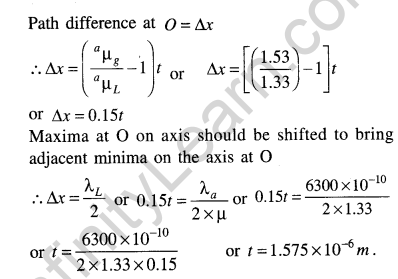
104.A thin plano-convex. Lens of focal length f is split into two halves. One of the halves is shifted along the optical axis. The separation between object and image planes is 1.8 m. The magnification of the image formed by one of the half lenses is 2. Find the focal length of the lens and separation between the two halves. Draw the ray diagram for image formation.[1996-5 marks]
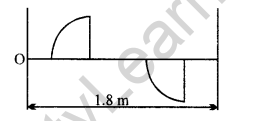
Ans.
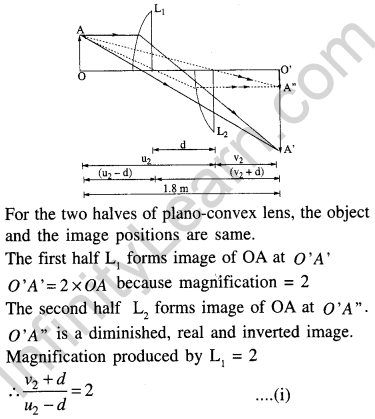
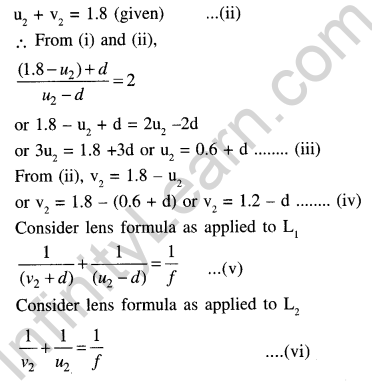
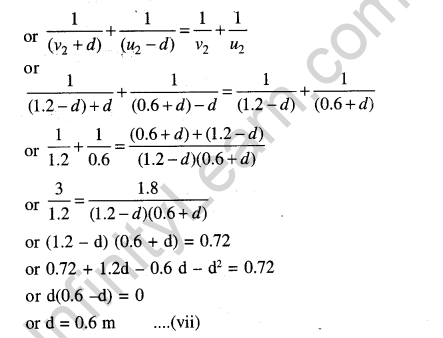
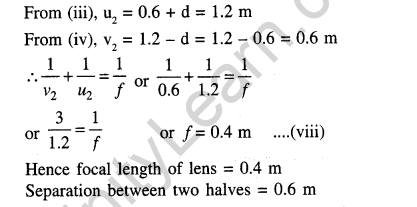
105.In Young’s experiment, the source is red light of wavelength 7 x 10-7 m . When a thin glass plate of refractive index 1.5 at this wavelength is put in the path of one of the interfering beams, the central bright fringe shifts by 10-3 m to the position previously occupied by the 5th bright fringe . Find the thickness of the plate . When the source is now changed to green light of wavelength 5 x 10 7 m, the central fringe shifts to a position initially occupied by the 6th bright fringe due to red light . Find the refractive index of glass for green light Also estimate the change in fringe width due to the change in wavelength. [1997-5 marks]
Ans.
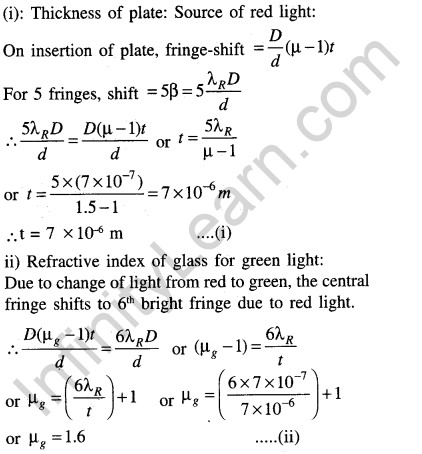

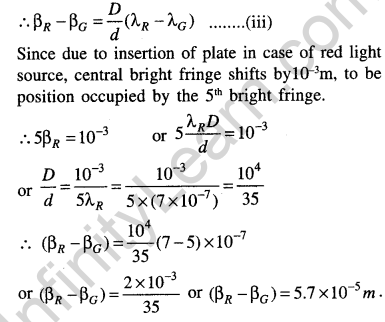

Ans.

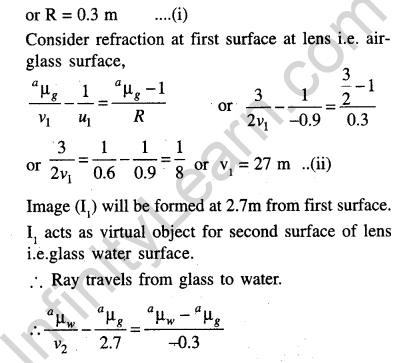

107.In Young’s experiment, the upper slit is covered by a thin glass plate of refractive index 1.4 while the lower slit is covered by another glass plate, having the same thickness as the first one but having refractive index 1.7 , Interference pattern is observed using light of wavelength 5400 A . It is found that the point P on the screen where the • central maximum (n 0) fell before the glass plates were inserted now has 3/4th of the original intensity . It is further observed that what used to be the 5th maximum earlier, lies below the point P while the 6th minimum lies above P. Calculate the thickness of the glass plate.(Absorption of light by glass plate may be neglected). [1997-5 marks]
Ans.
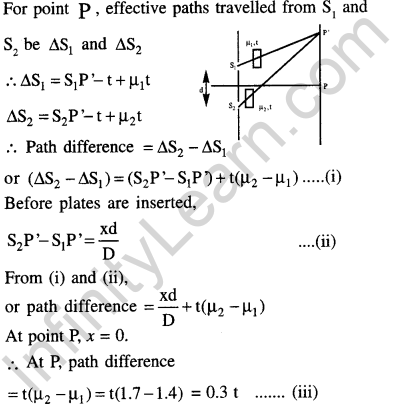

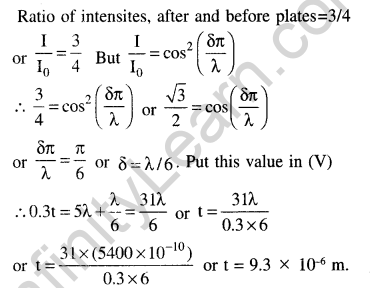


Ans.
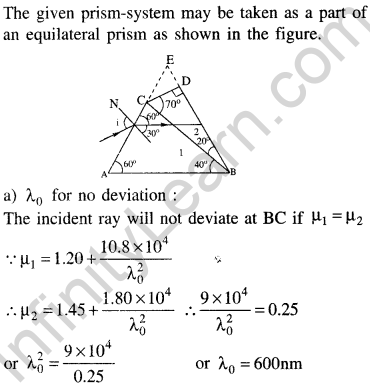

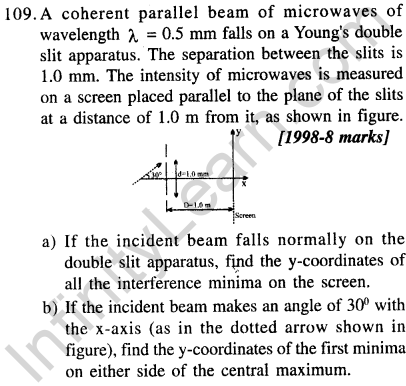

Ans.(a) When the incident beam falls normally: Let path difference =Ax
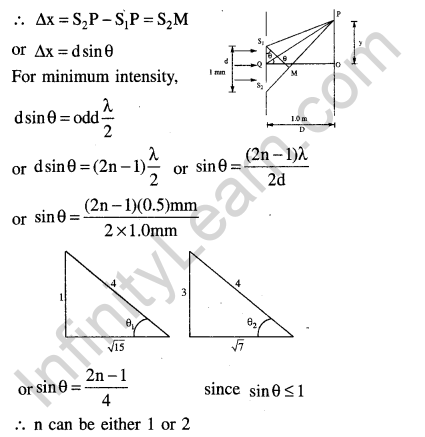
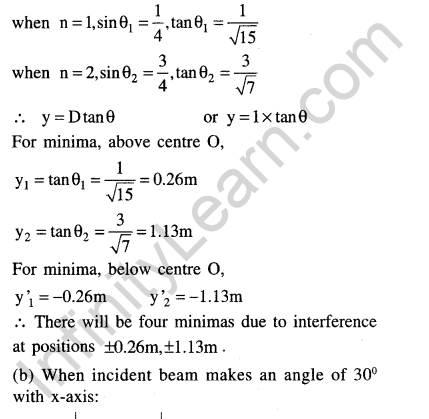
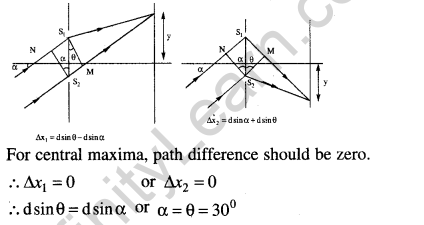
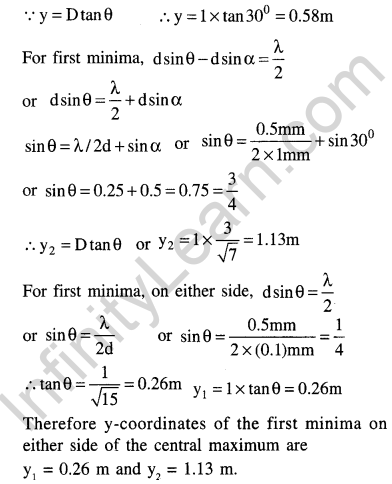
110.The Young’s double slit experiment is done in a medium of refractive index 4/3. A light of 600 nm wavelength is falling on the slits having 0.45 mm separation. The lower slit S2 is covered by a thin glass sheet of thickness 10.4 mm and refractive index 1.5. The interference pattern is observed on a screen placed 1.5 m from the slits as shown in figure [1999]
a)Find the location of the central maximum (bright fringe with zero path difference) on the y-axis.
b)Find the light intensity at point O relative to the maximum fringe intensity.
c)Now, if 600 nm light is replaced by white light of range 400 to 700nm, find the wavelength of the light that form maxima exactly at point O. [All wavelengths in this problem are for the given medium of refractive index 4/3. Ignore dispersion]
Ans.
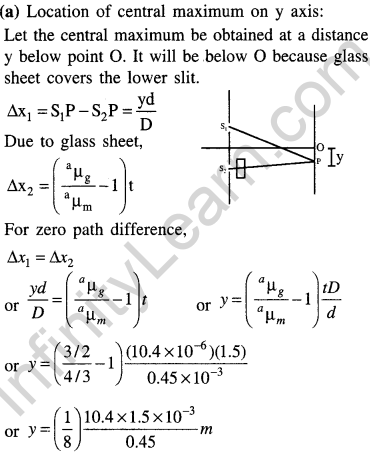
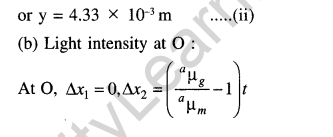
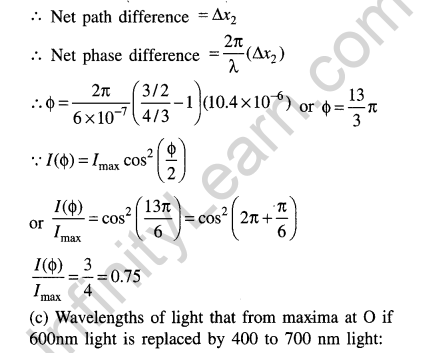
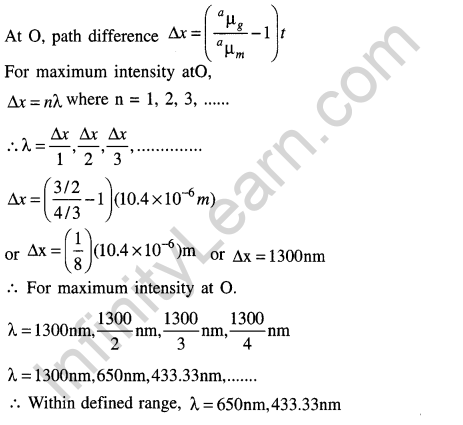

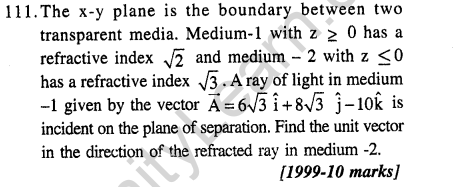
Ans.
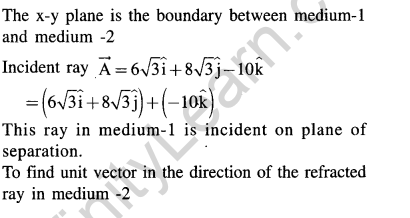
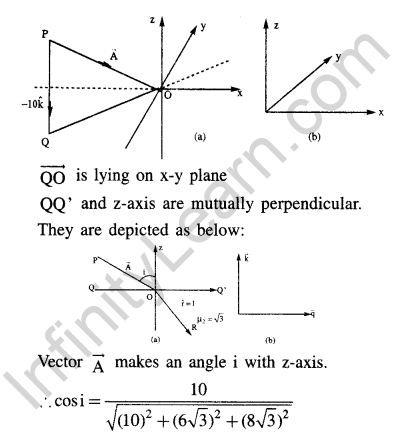
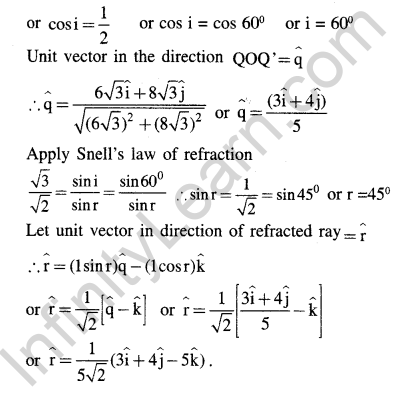
112.A quarter cylinder of radius R and refractive index 1.5 is placed on a table. A point object P is kept at a distance of mR from it. Find the value of m for which a ray from P emerge parallel to the table as shown in figure. [1999-5 marks]
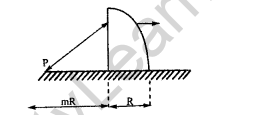
Ans.
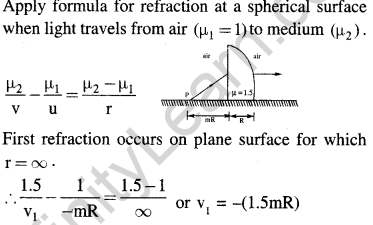
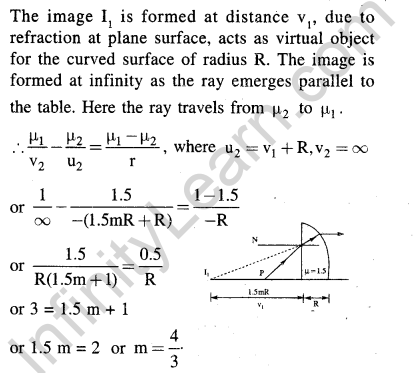
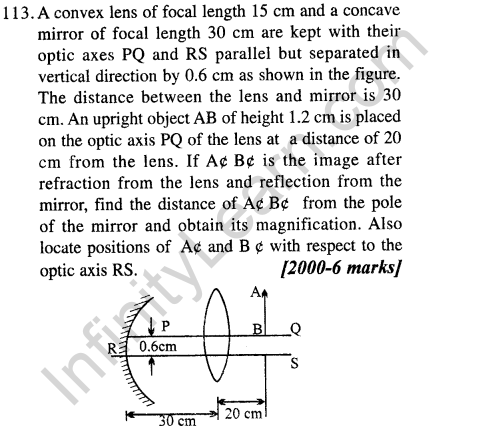
Ans.
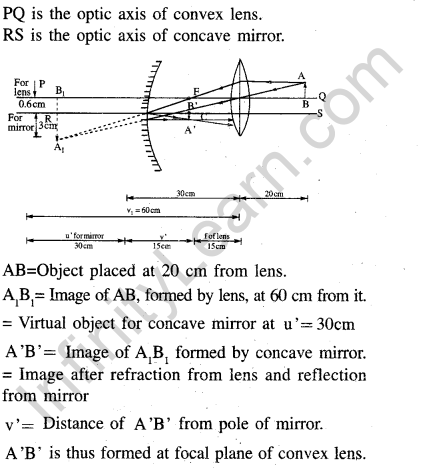

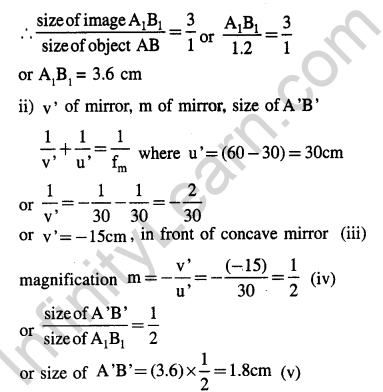
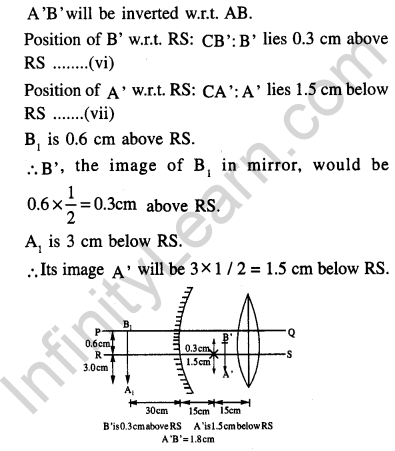
114.A glass plate of refractive index 1.5 is coated with a thin layer of thickness t and refractive index 1.8. Light of wavelength 1 travelling in air is incident normally on the layer. It is partly reflected at the upper and the lower surfaces of the layer and the two reflected rays interfere. Write the condition for their constructive interference. If 1 = 648 nm, obtain the least value of t for which the rays interfere constructively. [2000-4 marks]
Ans.
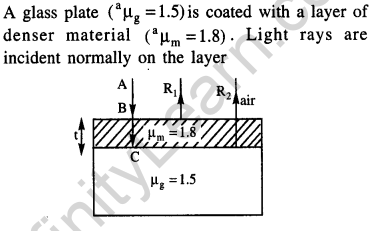
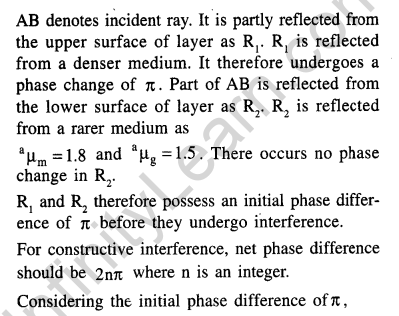
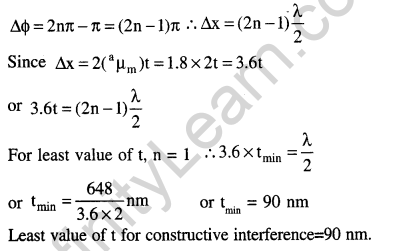
115.The refractive indices of the crown glass for blue and red lights are 1.51 and 1.49 respectively and those of the flint glass are 1.77 and 1.73 respectively. An isosceles prism of angle 6° is made of crown glass. A beam of white light is incident at a small angle on this prism. The other flint glass isosceles prism is combined with the crown glass prism such that there is no deviation of the incident light. Determine the angle of the flint glass prism. Calculate the net dispersion of the combined system. [2001-5 marks]
Ans.
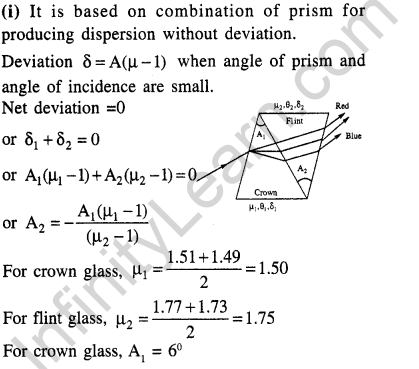
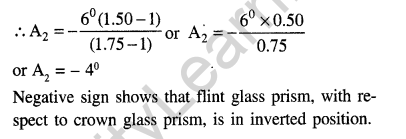

116.A vessel ABCD of 10 cm width has two small slits S1 and S2 sealed with identical glass plates of equal thickness. The distance between the slits is 0.8 mm. POQ is the line perpendicular to the plane AB and passing through O, the middle point of S1 and S2. A monochromatic light source is kept at S, 40 cm below P and 2 m from the vessel, to illuminate the slits as shown in the figure below. Calculate the position of the central bright fringe on the other wall CD with respect to the line OQ. Now, a liquid is poured into the vessel and filled up to OQ. The central bright fringe is found to be at Q. Calculate the refractive index of the liquid.[2001-5 marks]
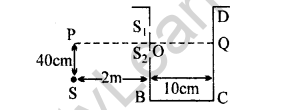
Ans.
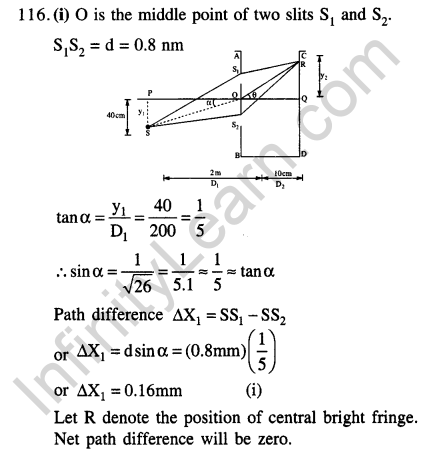
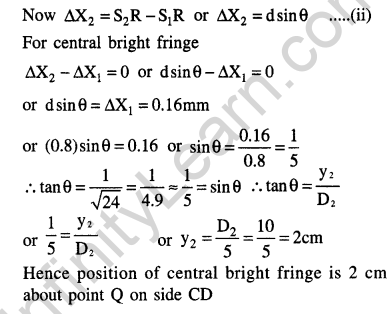
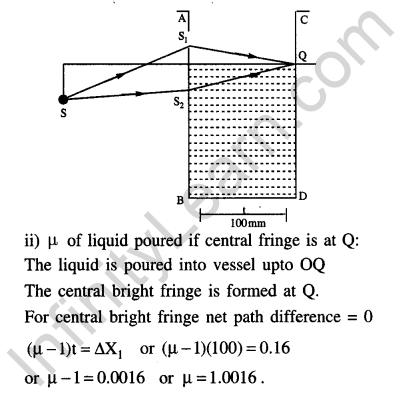
117.A thin biconvex lens of refractive index 3/2 is placed on a horizontal plane mirror as shown in the figure. The space between the lens and the mirror is then filled with water of refractive index 4/3. It is found that when a point object is placed 15cm above the lens on its principal axis, the object coincides with its own image. On repeating with another liquid, the object and the image again coincide at a distance 25cm from the lens. Calculate the refractive index of the liquid.[2001-5 marks]

Ans.
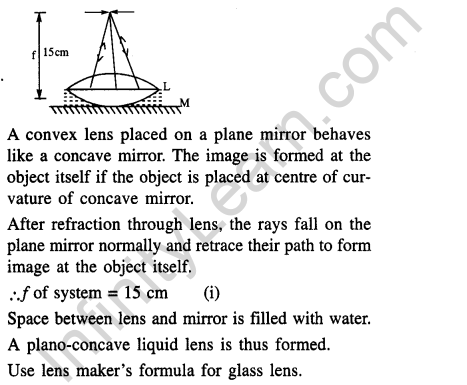

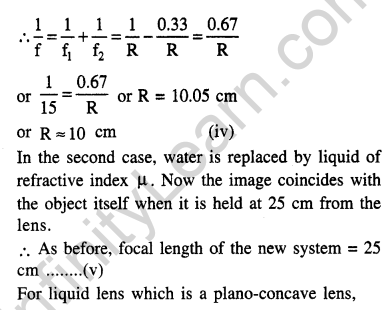
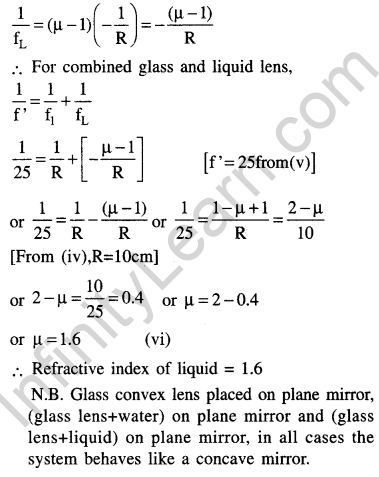
118.A point source S emitting light of wavelength 600 nm is placed at a very small height h above a flat reflecting surface AB (see figure). The intensity of the reflected light is 36% of the incident intensity.Interference fringes are observed on a screen placed parallel to the reflecting surface at a very large distance D from it. [2002-5 marks]
a)What is the shape of the interference fringes on the screen?
b)Calculate the ratio of the minimum to the maximum intensities in the interference fringes formed near the point P (shown in the figure).
c)If the intensity at point P corresponds to a maximum, calculate the minimum distance through which the reflecting surface AB should be shifted so that the intensity at P again becomes maximum.
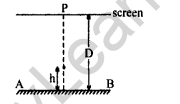
Ans.
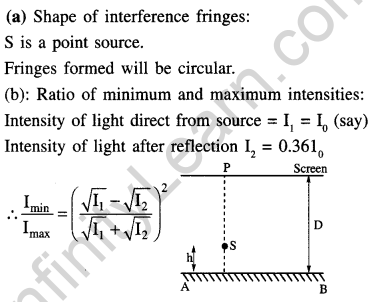
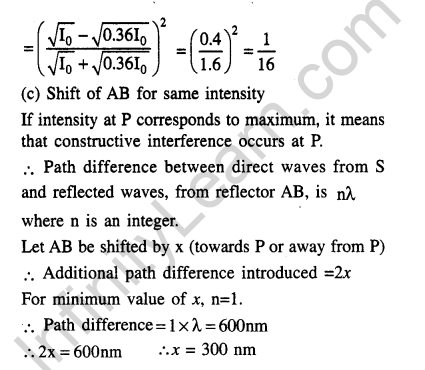
119.Find the focal length of the lens shown in the figure. The radii of curvature of both the surfaces are equal to R. [2003-2 marks]
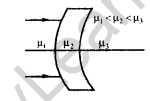
Ans.
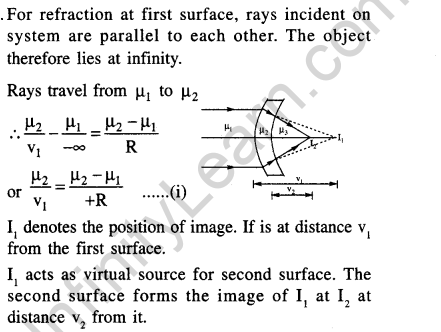

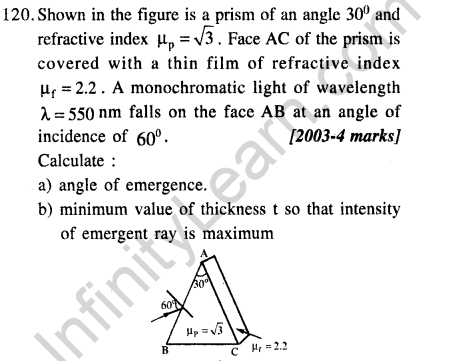
Ans.
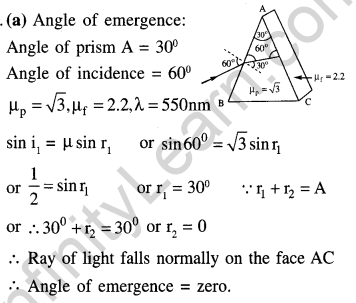
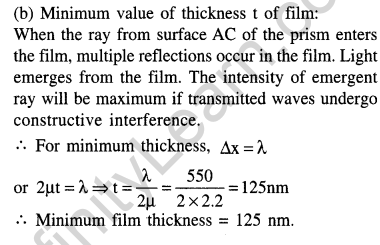
121.A ray is incident on a medium consisting of two boundaries, one plane and other curved as shown in the figure. The plane surface makes an angle 60° with horizontal and curved surface has radius of curvature 0.4m. The refractive indices of the medium and its environment are shown in the figure. If after refraction at both the surfaces the ray meets principal axis at P, find OP.[2004-2 marks]
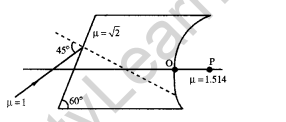
Ans.
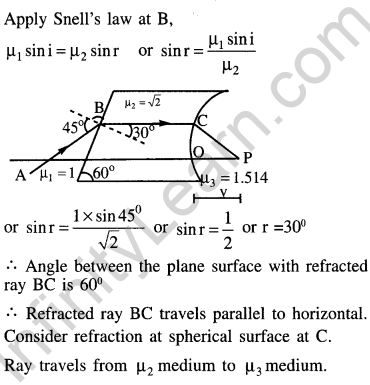


122.In Young’s double slit experiment, a light containing two wavelengths 500 nm and 700 nm are used. Find the minimum distance where maxima of two wavelengths coincide. Given D/d = 10 3 where D is the distance between the slits and the screen and d is the distance between the slits. [2004-4 marks]
Ans.
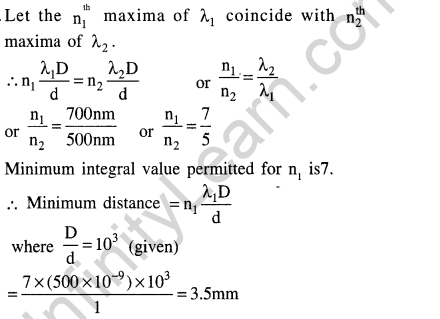
123.An object is moving with velocity 0.01 m/s towards a convex lens of focal length 0.3m. Find the magnitude of rate of separation of image from the lens when the object is at a distance of 0.4m from the lens. Also calculate the magnitude of the rate of change of the lateral magnification.[2004 – 4 marks]
Ans.
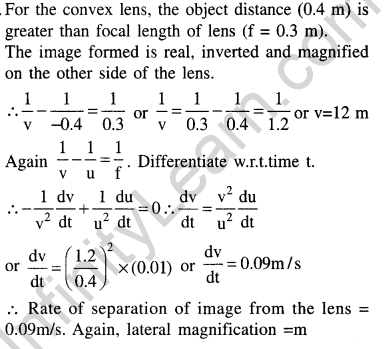
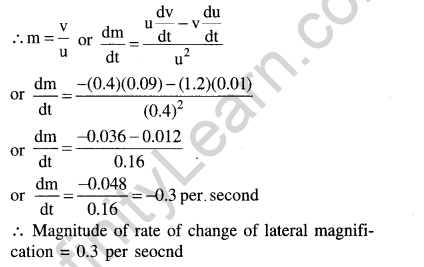
124.What will be the minimum angle of incidence such that the total internal reflection occurs on both the surfaces? [2005-2 marks]
Ans.
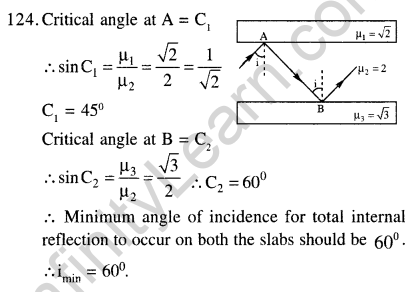
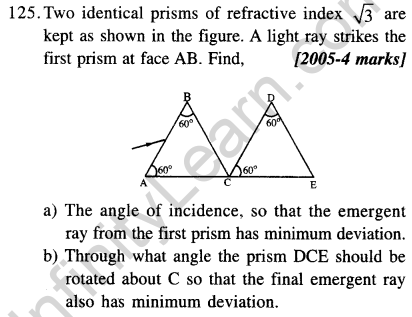
Ans.

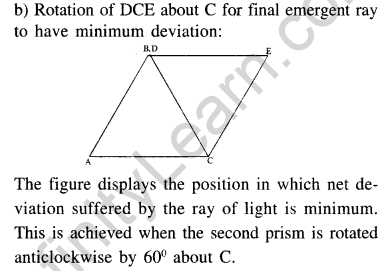

Ans.


Ans.
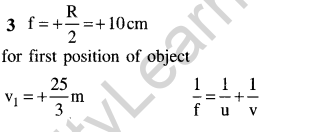
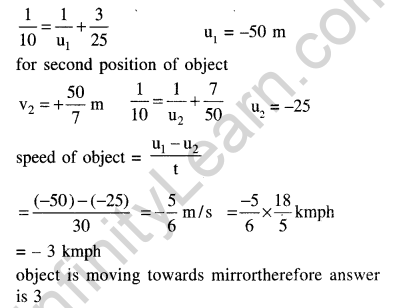

Ans.
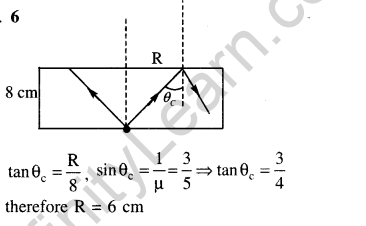
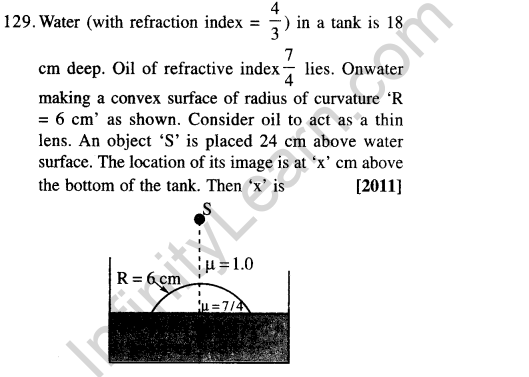
Ans.
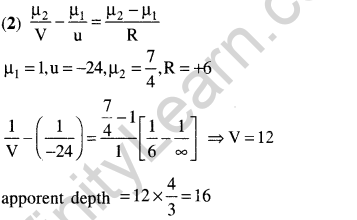
True / False
130.The setting sun appears higher in the sky than it really is [1980]
Ans.True : At sunset, the sun appears red because in travelling through longer dust path, violet, blue, yellow and orange rays mostly get scattered away and the only light that reaches the earth is red.
131.The intensity of light at a distance r from the axis of a long cylindrical source is inversely proportional to r. [1981-2 marks]
Ans.
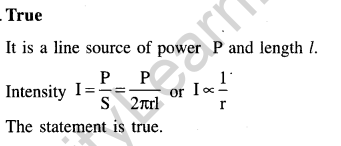
132.A convex lens of focal length 1 metre and a concave lens of focal length 0.25 metre are kept 0.75 metre apart. A parallel beam of light first passes through the convex lens, then through the concave lens and comes to a focus 0.5m away from the concave lens. [1983-2 marks]
Ans.

133.A beam of white light passing through a hollow prism gives no spectrum. [1983-2 marks]
Ans.
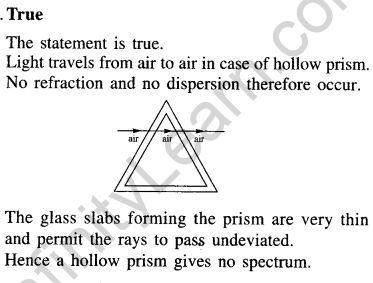
134.The two slits in a Young’s double slit experiment are illuminated by two different sodium lamps emitting light of the same wavelength. No interference pattern will be observed on the screen[1984-2 marks]
Ans.True : For sustained interference pattern, the two sources should be coherent. Two different lamps cannot act as coherent sources. Hence no interference pattern will be observed on the screen.
135.In Young’s double slit experiment, performed with a source fo white light, only black and white fringes are observed. [1987-2 marks]
Ans.False : With source of white light, Young’s double slit experiment gives coloured fringes on either side of the central white fringe.
136.A parallel beam of white light falls on a combination of a concave and a convex lens, both of the same material. Their focal lengths are 15 cm and 30 cm respectively for the mean wavelength in white light. On the other side of the lens system, one sees coloured patterns with violet colour at the outer edge. [1988-2 marks]
Ans.
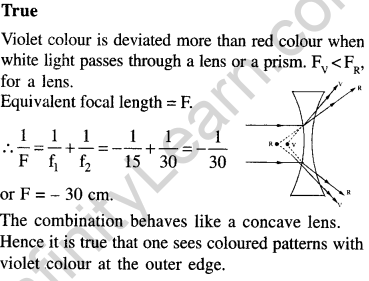
Fill in the blanks
137.A light wave of frequency 5 x 1014 Hz enters a medium of refractive index 1.5. In the medium the velocity of the light wave is ………………… and its wavelength is……………………….. [1983-2 marks]
Ans.

138.A convex lens A of focal length 20 cm and a concave lens B of focal length 5 cm are kept along the same axis with a distance d between them. If a parallel beam of light falling on A leaves B as a parallel beam, then d is equal to…………………………………….. cm. [1985-2 marks]
Ans.

139.A monochromatic beam of light of wavelength 6000 A in vacuum enters a medium of refractive index 1.5. In the medium, its wavelength is………. , its frequency is……………………… [1985-2 marks]
Ans.
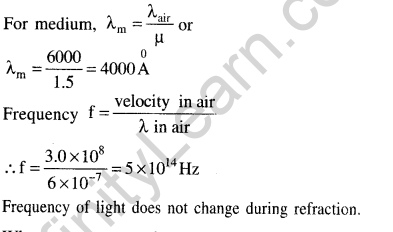
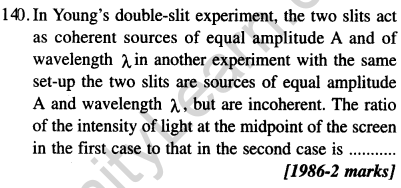
Ans.
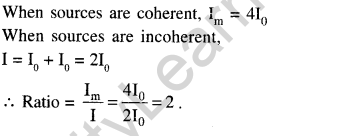
141.A thin lens of refractive index 1.5 has a focal length of 1.5cm in air. When the lens is placed in a medium of refractive index 4/3, its focal will become……………… cm. [1987-2 marks]
Ans.

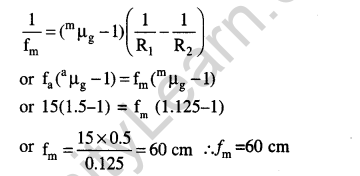
142.A point source emits waves equally in all directions in a non-absorbing medium. Two points P and Q are at a distance of 9 metre and 25 metre respectively from the source. The ratio of amplitudes of the waves at P and Q is…………[1989-2 marks]
Ans.
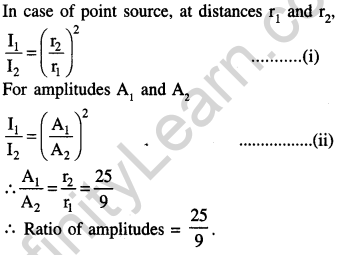
143.A slab of a material of refractive index 2 shown in fig. has a curved surface APB of radius of curvature 10 cm and a plane surface CD. On the left of APB is air and on the right of CD is water with refractive indices as given in the figure. An object O is placed at a distance of 15 cm from the pole P as shown. The distance of the final image of O from P, as viewed from the left is………..[1991-2 marks]

Ans.
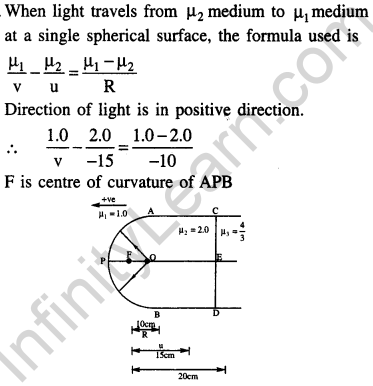
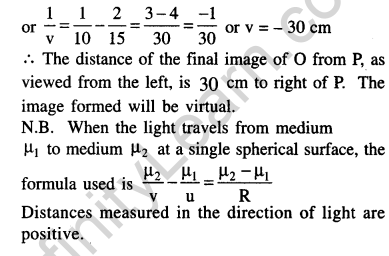

Ans.
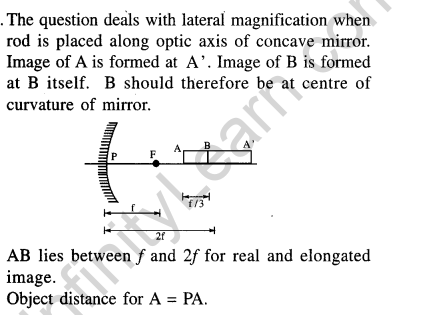
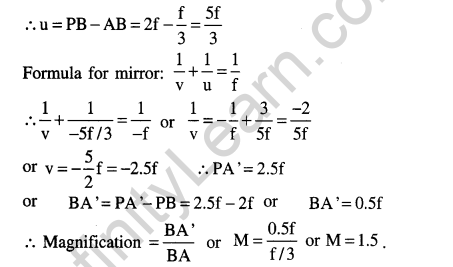

Ans.
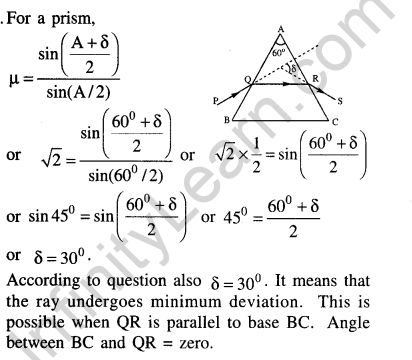
146.The resolving power of electron microscope is higher than that of an optical microscope because the wavelength of electrons is …………… than the wavelength of visible light [1992-1 mark]
Ans. The resolving power of a microscope is inversely proportional to the wavelength used.The resolving power of an electron microscope is higher than that of an optical microscope because the de Broglie wavelength associated with electron is much smaller than the wavelength of light.
147.A slit of width d is placed in front of a lens of focal length 0.5m and is illuminated normally with light of wavelength 5.89 x 10-7 m. The first diffraction minima on either side of the central diffraction maximum are separated by 2 X 10-3 m. The width d of the slit is……….. m. [1997-1 mark]
Ans.
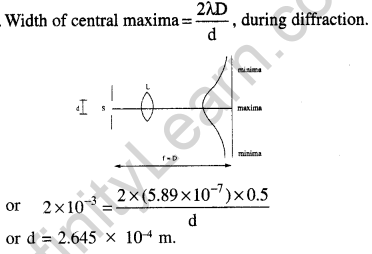
148.Two thin lenses, when in contact, produce a combination of power +10 dioptre. When they are 0.25 m part, the power reduces to +6 The focal length of the lenses are …………. m and…………..m[1997-2 mark]
Ans.
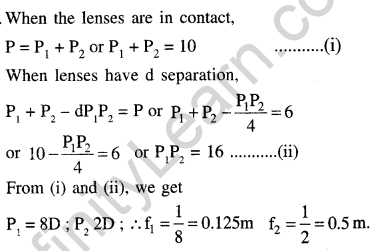

Ans.
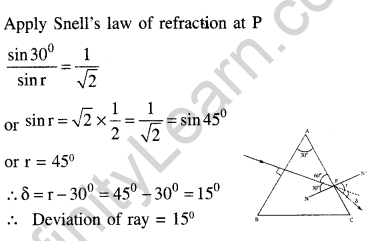
150.An image Y is formed of point object X by a lens whose optic axis is AB as shown in figure. Draw a ray diagram to locate the lens and its focus. If the image Y of the object X is formed by a concave mirror (having the same axis as AB) instead of lens, draw another ray diagram to locate the mirror and its focus. Write down the steps of construction of the ray diagrams. [1994-6 marks]
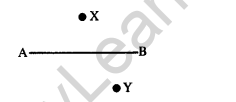
Ans.

